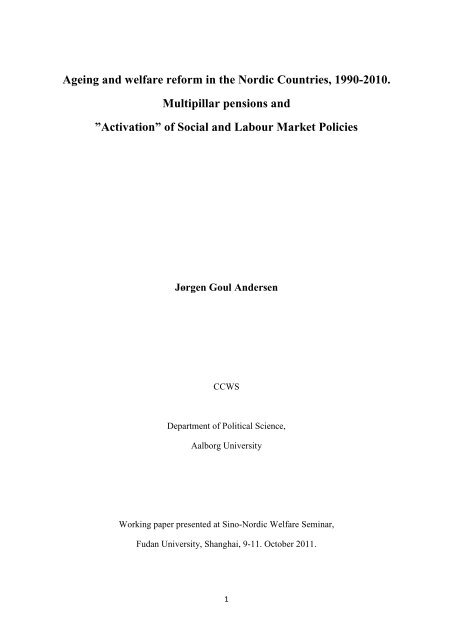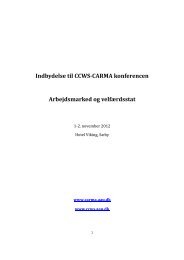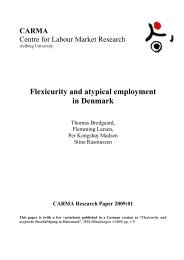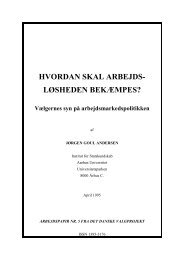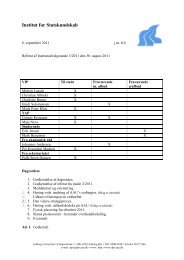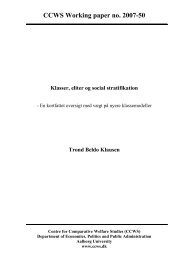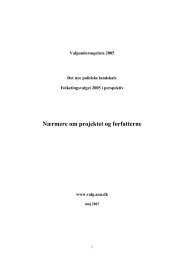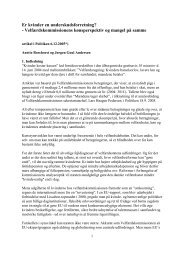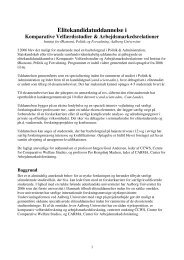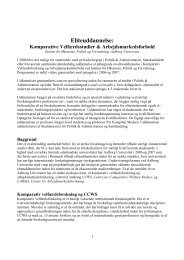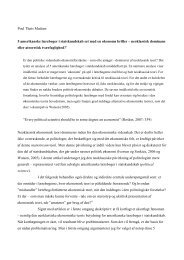Ageing and welfare reform in the Nordic Countries, 1990-2010 ...
Ageing and welfare reform in the Nordic Countries, 1990-2010 ...
Ageing and welfare reform in the Nordic Countries, 1990-2010 ...
You also want an ePaper? Increase the reach of your titles
YUMPU automatically turns print PDFs into web optimized ePapers that Google loves.
<strong>Age<strong>in</strong>g</strong> <strong>and</strong> <strong>welfare</strong> <strong>reform</strong> <strong>in</strong> <strong>the</strong> <strong>Nordic</strong> <strong>Countries</strong>, <strong>1990</strong>-<strong>2010</strong>.Multipillar pensions <strong>and</strong>”Activation” of Social <strong>and</strong> Labour Market PoliciesJørgen Goul AndersenCCWSDepartment of Political Science,Aalborg UniversityWork<strong>in</strong>g paper presented at S<strong>in</strong>o-<strong>Nordic</strong> Welfare Sem<strong>in</strong>ar,Fudan University, Shanghai, 9-11. October 2011.1
1. IntroductionAs regards demographic change, <strong>Nordic</strong> countries are less under pressure than most Europeancountries. As Esp<strong>in</strong>g-Andersen (2009: 4) puts it, ”pension <strong>reform</strong> beg<strong>in</strong>s with babies”, <strong>and</strong> due to”pro-natal” child policies, all <strong>the</strong> <strong>Nordic</strong> countries have ma<strong>in</strong>ta<strong>in</strong>ed relatively high fertility ratesclose to 2.0 (Table 1). 1 Even though <strong>the</strong> ratio of elderly people (65 years or more) to work<strong>in</strong>g agepopulation (15-64 years) will <strong>in</strong>crease substantially from about 25 per cent to slightly above 40 percent from <strong>2010</strong> to 2050, <strong>the</strong> <strong>Nordic</strong> countries will rema<strong>in</strong> relatively ”young” by European st<strong>and</strong>ards(Figure 1). By comparison, <strong>the</strong> old age dependency ratio <strong>in</strong> Japan is expected to pass <strong>the</strong> 40 per centlevel already by 2013, <strong>and</strong> <strong>in</strong> Japan, <strong>the</strong> old age dependency ratio is expected to reach almost twice<strong>the</strong> <strong>Nordic</strong> level <strong>in</strong> <strong>the</strong> 2050s (Table 2; Figure 2).Table 1. Fertility <strong>and</strong> Life Expectancy at Birth, European <strong>and</strong> OECD <strong>Countries</strong>, 2009.FertilityLife expectancyMenWomenIcel<strong>and</strong> 2.23 79.8 83.8Norway 1.98 78.7 83.3Denmark 1.84 76.9 81.1Sweden 1.94 79.4 83.5F<strong>in</strong>l<strong>and</strong> 1.86 76.6 83.5France 2.00 78.0 85.0UK 1.94 77.8 81.9Ne<strong>the</strong>rl<strong>and</strong>s 1.79 78.7 82.9Belgium 1.84 77.3 82.8Germany 1.36 77.8 82.8Austria 1.39 77.6 83.2Switzerl<strong>and</strong> 1.50 79.9 84.6Italy 1.42 79.3 84.7Spa<strong>in</strong> 1.40 78.7 84.9Pol<strong>and</strong> 1.40 71.5 80.1Japan (2008) 1.37 79.3 86.1USA (2009/07) 2.05 75.4 80.4Source: Eurostat, Jap.Stat.Yearbook, US Census.None <strong>the</strong> less, <strong>the</strong> <strong>Nordic</strong> countries have adopted encompass<strong>in</strong>g policy changes <strong>in</strong> order to address<strong>the</strong> demographic challenge. This <strong>in</strong>cludes not only pension <strong>reform</strong>s, but also an “activation” of <strong>the</strong>entire social <strong>and</strong> tax policy <strong>in</strong> order to stimulate labour supply. The latter has aimed at improv<strong>in</strong>g1 High-quality child care, parental leve <strong>and</strong> child benefits is seen as <strong>the</strong> source of what is sometimes described as a<strong>Nordic</strong> fertility regime (Andersson et al., 2009). Empirical evidence regard<strong>in</strong>g determ<strong>in</strong>ants of fertility rema<strong>in</strong> disputed.But it is generally agreed that several socio-economic determ<strong>in</strong>ants of fertility have reversed (Billari & Kohler, 2004;Myrskylä et al., 2009; Bloom & Souza-Poza, <strong>2010</strong>), <strong>and</strong> most studies converge towards see<strong>in</strong>g pro-natal policiesembedded <strong>in</strong> a (policy-nourished) familiy friendly culture as fertility-enhanc<strong>in</strong>g (Sleebos, 2003; Hilgeman & Butts,2009; Hoem, 2008).2
employment <strong>in</strong>centives as well as <strong>in</strong>centives to work longer hours. The “activation” of socialprotection <strong>and</strong> taxes have addressed short-term goals as well, but worries about dependency ratios<strong>in</strong> an age<strong>in</strong>g society have been a major underly<strong>in</strong>g concern. Even dur<strong>in</strong>g <strong>the</strong> f<strong>in</strong>ancial crisis from2008 onwards, stimulat<strong>in</strong>g labour supply has rema<strong>in</strong>ed a core policy goal. This paper brieflyaddresses both <strong>the</strong> “narrow” <strong>and</strong> <strong>the</strong> “broader” adaptation to <strong>the</strong> challenge of age<strong>in</strong>g.Figure 1. Projected old-age dependency ratios <strong>in</strong> EU <strong>Countries</strong> <strong>and</strong> Japan, 2050. Population65 years or more as per cent of population 15-64 yearsTable 2. Old age dependency ratios, 2000, <strong>2010</strong> <strong>and</strong> 2050 (projections).65 y.+ as per cent of 15-64 y. 2000 <strong>2010</strong> 2050Denmark 22.2 24.9 41.3Norway 23.5 22.5 41.4F<strong>in</strong>l<strong>and</strong> 22.2 25.6 46.6Sweden 26.9 27.7 41.9UK 24.3 24.9 38.0NL 20.0 22.8 45.6France 24.3 25.6 44.7Belgium 25.6 26.0 43.9Germany 23.9 31.4 56.4Italy 26.8 30.8 59.2Spa<strong>in</strong> 24.5 24.7 58.7Pol<strong>and</strong> 17.6 19.0 55.7Japan 25.5 36.2 76.42000+<strong>2010</strong>: http://epp.eurostat.ec.europa.eu/tgm/table.do?tab=table&<strong>in</strong>it=1&language=en&plug<strong>in</strong>=1&pcode=tsdde5103
Figure 2. Old Age Dependency Ratio <strong>in</strong> Japan, <strong>2010</strong>-2055.90Japan. Old Age Dependency Ratio <strong>2010</strong>-2055. Per cent807060504030<strong>2010</strong>0<strong>2010</strong>20122014201620182020202220242026202820302032203420362038204020422044204620482050205220542. <strong>Age<strong>in</strong>g</strong>, pensions <strong>and</strong> retirementEven though long-term demographic problems are small, comparatively speak<strong>in</strong>g, <strong>the</strong> <strong>Nordic</strong>countries have been proactive <strong>in</strong> chang<strong>in</strong>g <strong>the</strong>ir pension/retirement systems (NOSOSCO, 2009a,b;NOSOSKO 2009; Kangas, Lundberg & Ploug, <strong>2010</strong>). Formally speak<strong>in</strong>g, at least, this hashappened <strong>in</strong> highly different ways. All <strong>Nordic</strong> countries departed from an old flat rate people’spension model, but <strong>in</strong> different directions.In <strong>the</strong> 1960’s Sweden, F<strong>in</strong>l<strong>and</strong> <strong>and</strong> Norway added a second, earn<strong>in</strong>gs-related tier to <strong>the</strong> people’spension. The Danish labour movement was divided on <strong>the</strong> issue, however, <strong>and</strong> Denmark <strong>in</strong>steadcont<strong>in</strong>ued to improve <strong>the</strong> people’s pension (Albrekt Larsen & Goul Andersen, 2004). Like o<strong>the</strong>r”laggards” fail<strong>in</strong>g to <strong>in</strong>troduce a public earn<strong>in</strong>gs-related pension dur<strong>in</strong>g <strong>the</strong> ”golden age” of <strong>the</strong><strong>welfare</strong> state (Myles & Pierson, 2001), Denmark moved directly to a multipillar system (resembl<strong>in</strong>gAustralia, Switzerl<strong>and</strong>, <strong>and</strong> to some extent <strong>the</strong> Ne<strong>the</strong>rl<strong>and</strong>s <strong>and</strong> UK).In Denmark, <strong>the</strong> transformation of <strong>the</strong> pension system was carried through without any formalpension <strong>reform</strong>, <strong>in</strong> fact without any legislation. Instead, a layer of fully funded labour marketpensions were <strong>in</strong>troduced via collective negotiations. In pr<strong>in</strong>ciple, Danish labour market pensionsare completely private pensions unlike <strong>the</strong> public pensions <strong>in</strong> Sweden <strong>and</strong> Norway, but due to ahigh union density, collective negotiated arrangements typically have <strong>the</strong> same impact asarrangements adopted by legislation. At least, this is a very collective form of privatization, <strong>in</strong>practice semi-public. In Denmark, fur<strong>the</strong>rmore, <strong>the</strong> classical people’s pension (<strong>and</strong> o<strong>the</strong>r first pillarstate pensions) were ma<strong>in</strong>ta<strong>in</strong>ed, albeit <strong>in</strong> a more targeted version (Goul Andersen, 2007a, 2008,2011); see also below.4
In <strong>the</strong> o<strong>the</strong>r countries (Norway to be implemented by 2011) <strong>the</strong> two-tier people’s pension (withdef<strong>in</strong>ed benefit 2 earn<strong>in</strong>gs-related supplement) was replaced by (partly funded) def<strong>in</strong>ed contributionschemes with social m<strong>in</strong>ima (Figure 3). Arguably, <strong>the</strong>se countries moved closer to a Bismarckiansystem, from a mixture of def<strong>in</strong>ed contribution/def<strong>in</strong>ed benefit pr<strong>in</strong>ciples towards more strictdef<strong>in</strong>ed contribution systems. This streng<strong>the</strong>n<strong>in</strong>g of <strong>the</strong> def<strong>in</strong>ed contribution pr<strong>in</strong>ciple – strictlyrelat<strong>in</strong>g pensions to contributions <strong>and</strong> thus provid<strong>in</strong>g unmodified <strong>in</strong>centives to work – is similar towhat is found <strong>in</strong> most countries. The def<strong>in</strong>ed contribution pr<strong>in</strong>ciple is also embodied <strong>in</strong> <strong>the</strong> fundedDanish labour market pensions.Figure 3. (A) Def<strong>in</strong>ed contribution pensions with a social m<strong>in</strong>imum pension. (B) Multipillarsystem with people’s pension <strong>and</strong> labour market pension.In practice, <strong>the</strong> difference between <strong>the</strong> Danish system (Figure 3.B) <strong>and</strong> <strong>the</strong> o<strong>the</strong>r <strong>Nordic</strong> ones(Figure 3.A) is not extremely big. In some <strong>in</strong>stances, a targeted people’s pension <strong>and</strong> a m<strong>in</strong>imumpension, comb<strong>in</strong>ed with a def<strong>in</strong>ed contribution pension scheme are equivalent. The difference <strong>in</strong>outcomes depend mostly on <strong>the</strong> size of <strong>the</strong> m<strong>in</strong>imum pension. With appropriate sett<strong>in</strong>gs of <strong>the</strong>m<strong>in</strong>imum pension, <strong>the</strong> <strong>Nordic</strong> systems may produce roughly <strong>the</strong> same outcome. In practice, <strong>the</strong>m<strong>in</strong>imum level <strong>in</strong> Denmark is higher than <strong>in</strong> Sweden if <strong>the</strong> preferential rules for pensioners’hous<strong>in</strong>g benefits are taken <strong>in</strong>to account (Hatl<strong>and</strong>, 2011). The after tax value of pensions <strong>and</strong> o<strong>the</strong>rbenefits for a s<strong>in</strong>gle pensioner without any o<strong>the</strong>r <strong>in</strong>come is equivalent to maximum unemploymentbenefits (Goul Andersen, 2007a)2 Pension entitlements can ei<strong>the</strong>r be based on <strong>the</strong> pr<strong>in</strong>ciple of def<strong>in</strong>ed benefit or on def<strong>in</strong>ed contribution. The lattermeans that entitlements are directly determ<strong>in</strong>ed by contributions (also labelled actuarial fairness). Def<strong>in</strong>ed benefitmeans that entitlements are politically def<strong>in</strong>ed <strong>in</strong> a way, that modifies or elim<strong>in</strong>ates <strong>the</strong> strict calculation of pensionsfrom contributions. Typically, such pensions have been def<strong>in</strong>ed as a fixed proportion of <strong>the</strong> wage over a certa<strong>in</strong> numberof years, provided that some m<strong>in</strong>imum requirement is fulfilled (for <strong>in</strong>stance, 30-40 years of contributions).5
In addition, Denmark, Sweden <strong>and</strong> F<strong>in</strong>l<strong>and</strong> have ma<strong>in</strong>ta<strong>in</strong>ed very generous hous<strong>in</strong>g benefit schemesfor pensioners 3 which should be counted as part of <strong>the</strong> first pillar (state) pensions. These schemesare highly important as regards protection aga<strong>in</strong>st poverty.Figure 4. Pillars <strong>and</strong> tiers of <strong>the</strong> Danish Multipillar Pension System.Third Tier(topp<strong>in</strong>g up /replacement gap)Second/third tier(<strong>in</strong>comema<strong>in</strong>tenance)First tier(basic security/poverty protection)First Pillar Second Pillar Third PillarOccupational pensions Personal pensionsState pensions <strong>and</strong> specialarrangements for pensionersSP: Special Pensions sav<strong>in</strong>gs(term<strong>in</strong>ated 2009)ATP: Supplementary Labour MarketPensionPeople’s pension Basic AmountPensionsupplementSupplementary pensions benefitsIndividual supplements(health, personal, heat<strong>in</strong>g)Preferential hous<strong>in</strong>g benefitsSemi-m<strong>and</strong>atory labourmarket pensionCivil servants’ pensions(Company pensions)*Rent pensionCapital pensionRate pension(Index contracts)Notes: Light Grey: Means-tested. Dark Blue: Funded*) For civil servants <strong>in</strong> municipalities, pensions are often funded through <strong>in</strong>surance <strong>in</strong> order to avoid f<strong>in</strong>anc<strong>in</strong>g labour power of <strong>the</strong>past through current expenses. Employee contracts as civil servants have decl<strong>in</strong>ed very significantly. The huge majority haveord<strong>in</strong>ary employment contracts.The Danish system (Figure 4) is <strong>in</strong> fact a socially balanced variant of a World Bank (1994) system,but it was <strong>in</strong>troduced several years before <strong>the</strong> World Bank issued its recommendations (Ploug,2001; Green-Pedersen, 2007). 4Sweden also has a very comprehensive system of collectively negotiated occupational pensions thatare formally private, but typically, contributions are significantly lower than <strong>in</strong> Denmark. Inaddition, <strong>in</strong>dividual pensions are grow<strong>in</strong>g (Kangas & Valdes, 2011; L<strong>in</strong>dquist & Wadensjö, 2011;Goul Andersen, 2011).In most countries, <strong>in</strong>equality among pensioners is expected to <strong>in</strong>crease. Chang<strong>in</strong>g <strong>the</strong> basicpr<strong>in</strong>ciples towards def<strong>in</strong>ed contribution means that <strong>in</strong>equality among <strong>the</strong> employed are reproduced<strong>in</strong> pension age. Denmark is an exception, however: Inequality among pensioners is not expected to<strong>in</strong>crease when <strong>the</strong> labour market pensions mature (Government, 2005:14).3 For F<strong>in</strong>l<strong>and</strong> see e.g. http://www.kela.fi/<strong>in</strong>/<strong>in</strong>ternet/english.nsf/NET/270808144314HS?OpenDocument. For Denmark<strong>and</strong> Sweden see Goul Andersen (2007a, 2011). In Denmark <strong>the</strong>re was a direct l<strong>in</strong>k s<strong>in</strong>ce payments of contributions to a”Social Pension Fund” for unspecified pension improvements (1971-1982) were f<strong>in</strong>ally decided to be applied forhous<strong>in</strong>g benefits.4 Collectively negotiated occupational pensions were not entirely new. They had been <strong>in</strong>troduced gradually over severaldeecades to a large m<strong>in</strong>ority of workers, <strong>in</strong> particular to white collars <strong>in</strong> <strong>the</strong> public sector (Andersen & Kristiansen,2009: 18-21, 39-47).6
pensions, early retirement <strong>and</strong> work <strong>in</strong>centivesVia <strong>the</strong> def<strong>in</strong>ed contribution pr<strong>in</strong>ciple, pension <strong>reform</strong>s <strong>in</strong> most countries also aim at streng<strong>the</strong>n<strong>in</strong>gwork <strong>in</strong>centives <strong>and</strong> postpone retirement. F<strong>in</strong>l<strong>and</strong> has fur<strong>the</strong>rmore <strong>in</strong>troduced a progressive accrualrate for people above 53 years to discourage early retirement (Kangas, 2007: 285). Throughout <strong>the</strong>period, Sweden ma<strong>in</strong>ta<strong>in</strong>ed <strong>the</strong> highest employment rates <strong>in</strong> <strong>the</strong> EU among 55-64 years olds, bothfor men <strong>and</strong> for women (73 <strong>and</strong> 67 per cent, respectively, by 2009). Norwegian figures are almostidentical. F<strong>in</strong>l<strong>and</strong> resorted to massive labour shedd<strong>in</strong>g for older workers <strong>in</strong> <strong>the</strong> early <strong>1990</strong>s, butfrom 1994 to 2009, employment rates <strong>in</strong>creased from 35 to 55 per cent for men, <strong>and</strong> from 32 to 57per cent for women among 55 to 64 years olds (table 3).In spite of generous early retirement from <strong>the</strong> age of 60 5 , Danish employment rates were higherthan <strong>in</strong> F<strong>in</strong>l<strong>and</strong> <strong>and</strong> <strong>in</strong> Cont<strong>in</strong>ental Europe dur<strong>in</strong>g <strong>the</strong> 1980s <strong>and</strong> <strong>1990</strong>s. On <strong>the</strong> o<strong>the</strong>r h<strong>and</strong>, a <strong>reform</strong><strong>in</strong> 1998 (fully implemented by 2004) which reduced early retirement benefits for claimants under<strong>the</strong> age of 62 was not too successful. Danish figures for <strong>the</strong> 55-64 years olds did not improve tooconv<strong>in</strong>c<strong>in</strong>gly. For <strong>in</strong>stance, employment rates among German <strong>and</strong> Dutch men caught up with <strong>the</strong>Danish figures. Among women, Danish employment rate rema<strong>in</strong>ed higher (51 per cent), but by2009, it was <strong>the</strong> lowest among <strong>the</strong> <strong>Nordic</strong> countries. 6 In <strong>the</strong> 1998 <strong>reform</strong>, pension age was loweredfrom 67 to 65 years, but this had no impact on employment rates for 65-66 years olds.Table 3. Employment rates (per cent of entire age group) among 55-64 years old, by gender.<strong>1990</strong>-2009. Percentages.Men 55-64 years oldWomen 55-64 years old<strong>1990</strong> 1994 1999 2004 2009 1994-2009<strong>1990</strong> 1994 2009 1994-2009Denmark 65.6 59.8 59.9 69.3 64.1 +5.3 42.4 40.2 50.9 +10.7F<strong>in</strong>l<strong>and</strong> 46.3 35.0 40.1 51.5 54.7 +19.7 39.7 32.1 56.5 +24.4Sweden 74.5 64.5 67.1 71.6 73.3 +8.8 64.7 59.3 66.8 +7.5Norway 70.7 69.3 73.6 73.2 72.8 +3.5 52.8 54.3 64.6 +10.3Icel<strong>and</strong> 92.6 92.3 93.2 87.1 85.0 -7.3 78.3 77.4 76.4 -1.0Austria - 39.8 41.6 36.8 51.0 +11.2 - 17.9 31.7 +13.8France 37.0 39.1 38.9 41.9 41.4 +2.3 25.0 28.1 36.7 +8.6Belgium 34.3 33.0 35.1 39.3 42.9 +9.9 9.4 12.4 27.7 +15.3Germany 52.0 47.5 48.0 48.8 63.8 +16.3 22.4 24.5 27.7 +3.2Ne<strong>the</strong>rl<strong>and</strong>s 44.5 40.7 48.8 56.4 61.7 +21.0 15.8 17.5 43.6 +26.1UK 62.4 56.6 59.4 65.4 66.1 +9.5 36.7 38.5 49.3 +10.8Switzerl<strong>and</strong> 85.2 79.1 78.9 76.7 77.1 -2.0 43.5 45.7 59.8 +14.1USA 65.2 62.6 66.1 66.0 65.2 +2.6 44.0 47.0 56.4 +9.4OECD 62.2 59.2 60.8 61.5 64.4 +5.2 33.5 33.9 45.1 +11.2Source: OECD Employment Outlook 1999, 2004,<strong>2010</strong>.5 Moreoever, from 1994-1996 <strong>the</strong>re was access to pre-early retirement for long-term unemployed from <strong>the</strong> age of 50(so-called ”transitional allowance” until ord<strong>in</strong>ary early retirement allowance from <strong>the</strong> age of 60).6 OECD data are survey based. Reliable register-based data reveal more improvement for Denmark. This holds even forlabour force participation rates. From 1997 to 2009, labour force participation rates for 55-59 years old <strong>in</strong>creased from80 to 83 per cent for men, <strong>and</strong> from 62 to 78 per cent for women. Among 60-64 years olds, corrrespond<strong>in</strong>g figures were43 <strong>and</strong> 52 per cent for men, <strong>and</strong> 18 percentage po<strong>in</strong>ts lower for women.7
Automatic adaptation of retirement to longeivityIn addition, all <strong>Nordic</strong> countries have been head<strong>in</strong>g towards automatic adaptation of retirement tolongeivity. The models are different, however. In Sweden, F<strong>in</strong>l<strong>and</strong> <strong>and</strong> Norway, contributions arefixed, <strong>and</strong> pensions are adjusted downwards accord<strong>in</strong>g to life expectancy by a special formula. Thismeans that people from <strong>the</strong> younger generations have to work longer if <strong>the</strong>y want to ma<strong>in</strong>ta<strong>in</strong> <strong>the</strong>same pension as previous generations.In Denmark, <strong>the</strong> same happens automatically for <strong>the</strong> labour market pensions as <strong>the</strong>y are fullyfunded. As regards public pensions, age brackets of pension <strong>and</strong> early retirement are fully <strong>in</strong>dexedto life expectancy for 60 years olds, tak<strong>in</strong>g 1979 as basel<strong>in</strong>e (this was decided <strong>in</strong> a broad politicalcompromise over <strong>the</strong> 2006 <strong>welfare</strong> <strong>reform</strong>; <strong>in</strong> 2011 <strong>the</strong> early retirement was nearly ab<strong>and</strong>oned). Iflife expectancy of Danes <strong>in</strong> 2023 is equivalent to life expectancy of <strong>the</strong> French around 2005,pension age <strong>in</strong> Denmark will be 70 years for people born after 1971. It is projected to <strong>in</strong>crease evenfur<strong>the</strong>r later on.Accord<strong>in</strong>g to a new political agreement <strong>in</strong> 2011, voluntary early retirement <strong>in</strong> Denmark is to bereduced from five to three years, <strong>and</strong> substantial deductions for pension assets makes <strong>the</strong> schemeunattractive <strong>in</strong> <strong>the</strong> future. Accord<strong>in</strong>gly, people can have <strong>the</strong>ir contributions paid back <strong>in</strong> 2012.Hence, <strong>in</strong> practice, <strong>the</strong> voluntary early retirement scheme <strong>in</strong>troduced <strong>in</strong> 1979 <strong>in</strong> order to provide animproved outlet <strong>and</strong> reduce youth unemployment, has been almost ab<strong>and</strong>oned. Like <strong>in</strong> Sweden,people face a choice between relatively early retirement <strong>and</strong> lower annual pensions, or lateretirement <strong>and</strong> higher annual pensions.Social <strong>in</strong>equalityProvided that health conditions improves roughly <strong>in</strong> accordance with life expectancy, <strong>and</strong> that <strong>the</strong>reare no social differences of importance, <strong>the</strong>se <strong>reform</strong>s are ”natural” adaptations to higher lifeexpectancy. At least <strong>in</strong> Denmark, however, <strong>the</strong> problem is that social differences <strong>in</strong> healthconditions <strong>and</strong> life expectancy are <strong>in</strong>creas<strong>in</strong>g, with very modest improvements at <strong>the</strong> lower level of<strong>the</strong> social or <strong>in</strong>come ladder.In short, <strong>the</strong> Danish <strong>reform</strong>s constitute a social problem s<strong>in</strong>ce health improvements are not equallydistributed across social classes. In this respect, <strong>the</strong> Danish <strong>reform</strong>s are tantamount to a privatizationof social risks that aggravate class <strong>in</strong>equality. Almost <strong>in</strong>evitable, although perhaps not to <strong>the</strong> samedegree, similar problems seem <strong>in</strong>evitable also <strong>in</strong> <strong>the</strong> o<strong>the</strong>r <strong>Nordic</strong> countries. If <strong>the</strong>re were no classdifferences <strong>in</strong> health <strong>and</strong> longeivity, <strong>the</strong>re would be a free choice between duration of retirement<strong>and</strong> annual pension; but unfortunately, this choice is not free for those who experience a certa<strong>in</strong>deterioration of health before pension age if this deterioration is not serious enough to obta<strong>in</strong>disability pension.In short, <strong>the</strong> <strong>Nordic</strong> countries have acted quite radically on <strong>the</strong> challenge of age<strong>in</strong>g. Increas<strong>in</strong>glongevity will affect <strong>the</strong> size of pensions, retirement age, or both. There is uncerta<strong>in</strong>ly about <strong>the</strong>effects as <strong>the</strong>re are many pathways to retirement, but <strong>in</strong> order to avoid deterioration of retirement<strong>in</strong>come, people will have to work longer if <strong>the</strong>y are able to do so.8
As regards susta<strong>in</strong>ability, <strong>the</strong> Danish pension system is <strong>in</strong> an exceptionally good situation. By mid-2011 <strong>the</strong> accumulated value of fully funded state, labour market <strong>and</strong> <strong>in</strong>dividual pensions amount to3.100 Bill Dkk. This is exactly equivalent to <strong>the</strong> value of <strong>the</strong> assets accumulated <strong>in</strong> <strong>the</strong> oil fund of<strong>the</strong> Norwegian state. 73. New target groups for employment effortsAs <strong>in</strong>dicated <strong>in</strong> <strong>the</strong> <strong>in</strong>troduction, <strong>the</strong> discussion about age<strong>in</strong>g <strong>and</strong> <strong>the</strong> decl<strong>in</strong><strong>in</strong>g labour force, relativeto <strong>the</strong> population, has catalyzed more general efforts to <strong>in</strong>crease <strong>the</strong> labour force. Such efforts goway beoynd <strong>the</strong> issue of retirement. Employment efforts have successively been extended to all <strong>the</strong>groups that were previously given low priority: The disabled, <strong>the</strong> sick, <strong>and</strong> long-term socialassistance clients. Besides, special exemptions for elderly unemployed <strong>and</strong> o<strong>the</strong>r difficult-to-placeworkers have been removed. F<strong>in</strong>ally, <strong>the</strong> <strong>Nordic</strong> countries have also put much more emphasis thanpreviously on <strong>the</strong> labour market <strong>in</strong>tegration of immigrants.As elsewhere <strong>the</strong> number of disability pensioners has grown <strong>in</strong> <strong>the</strong> <strong>Nordic</strong> countries. This wasparticularly outspoken <strong>in</strong> Norway where figures <strong>in</strong>creased from 236.000 <strong>in</strong> 1995 to 339.000 <strong>in</strong> 2008(NOSOSCO 2009a: 171; Øverbye, 2006). But figures close to 10 per cent of <strong>the</strong> work<strong>in</strong>g agepopulation (OECD, <strong>2010</strong>:103,134,145,162; http://dx.doi.org/10.1787/786611566183) has been asource of concern everywhere, <strong>and</strong> solutions have been difficult. A large number of measures havebeen applied <strong>in</strong> <strong>the</strong> attempt to reverse <strong>the</strong> trend. All <strong>Nordic</strong> countries have underl<strong>in</strong>ed that disabilitypension should only be granted on <strong>the</strong> basis of medical criteria, <strong>and</strong> only as a last resort. Allcountries have experimented with enabl<strong>in</strong>g people to take a job <strong>and</strong> have a ”sleep<strong>in</strong>g pension”meanwhile, or with grant<strong>in</strong>g disability pension on a temporary basis. In Sweden, <strong>the</strong> name”disability benefit” was even formally abolished by a <strong>reform</strong> (2003) <strong>in</strong> favour of an ”activity-<strong>and</strong>sickness benefit” (NOSOSCO, 2004; Riksrevisionen, 2005).Comprehensive changes <strong>in</strong> rules <strong>and</strong> procedures were <strong>in</strong>troduced <strong>in</strong> Denmark <strong>in</strong> 1998 <strong>and</strong> onwardsalongside <strong>the</strong> idea of an ”<strong>in</strong>clusive labour market” (OECD, 2003: 129; Bengtsson 2009; Bredgaard,2004), <strong>and</strong> of ”corporate social responsibility”. Besides, <strong>the</strong> <strong>in</strong>strument of ”flexible jobs” was<strong>in</strong>troduced as an alternative to disability pension for people with reduced work capacity. 8 From1998, application for disability pension should only take place after all possibilities of treatment,activation <strong>and</strong> rehabilitation had been considered. This was embodied <strong>in</strong> a disability pension <strong>reform</strong>adopted <strong>in</strong> 2001 <strong>and</strong> implemented <strong>in</strong> 2003, based on <strong>the</strong> pr<strong>in</strong>ciple of focuss<strong>in</strong>g on rema<strong>in</strong><strong>in</strong>gresources ra<strong>the</strong>r than on lost capacities. These programmes have enjoyed some success, <strong>and</strong> after aslow start <strong>the</strong> number of people work<strong>in</strong>g <strong>in</strong> permanently subsidized ”flexible jobs” has grown7 There are pension funds <strong>in</strong> Norway as well, but <strong>the</strong>ir accumulated assets are less than8 Flexible jobs typically allow people to work shorter hours <strong>and</strong>/or with less dem<strong>and</strong><strong>in</strong>g tasks while still ma<strong>in</strong>ta<strong>in</strong><strong>in</strong>g anord<strong>in</strong>ary wage follow<strong>in</strong>g collective agreements, <strong>and</strong> <strong>in</strong> pr<strong>in</strong>ciple ma<strong>in</strong>ta<strong>in</strong><strong>in</strong>g <strong>the</strong> same rights as ord<strong>in</strong>ary employees.The subsidy is normally 50-66 per cent.9
significantly. Even though a flexible job is considered a last resort before disability pension, somedeadweight losses are entailed, but <strong>in</strong> spite of a considerable growth of <strong>the</strong> vulnerable age groupsclose to pension age <strong>the</strong>re was no fur<strong>the</strong>r <strong>in</strong>creases <strong>in</strong> <strong>the</strong> number of disability pensioners.The growth <strong>in</strong> <strong>the</strong> number of disablement pensioners seems to have stopped <strong>in</strong> all four countries by<strong>2010</strong>. 9 It is noteworthy that <strong>the</strong> countries did not resort to lower disability pensions (which arecomparatively generous) <strong>in</strong> order to improve work <strong>in</strong>centives. Nor did <strong>the</strong> systems converge. InDenmark, disability pension har rema<strong>in</strong>ed a flat rate universal benefit accessible (<strong>in</strong> pr<strong>in</strong>ciple)regardless of employment record. In <strong>the</strong> o<strong>the</strong>r <strong>Nordic</strong> ccountries, benefits are earn<strong>in</strong>gs-related(NOSOSCO 2009a: 169; Blekesaune et al., <strong>2010</strong>). However, as some supplementary compensationis typically <strong>in</strong>cluded <strong>in</strong> Danish labour market pension agreements, outcomes are not that different.But it rema<strong>in</strong>s that <strong>the</strong> Danish scheme is <strong>the</strong> most generous for people with low wages (or no<strong>in</strong>come), <strong>and</strong> benefits were fur<strong>the</strong>rmore improved, both by <strong>the</strong> 2001 <strong>reform</strong> (for a s<strong>in</strong>gle person,pension is roughly equal to maximum unemployment benefits), <strong>and</strong> by new supplements for someof those who rema<strong>in</strong>ed under <strong>the</strong> old rules. Even though one could expect that restricted access todisablement pensions would mean higher take up of voluntary early retirement, Danish <strong>and</strong>Norwegian figures do not <strong>in</strong>dicate such correspondence.Ano<strong>the</strong>r target group was long term sickness benefit recipients. Especially <strong>in</strong> Norway <strong>and</strong> Swedenwhere <strong>the</strong> number of recipients has been except<strong>in</strong>ally high (OECD, <strong>2010</strong>:162), sickness benefits hasbeen considered a problem by itself. Both countries have experimented with longer duration ofemployers’ responsibilities as an attempt to improve <strong>in</strong>centives, but seem<strong>in</strong>gly with few results. InNorway (<strong>and</strong> more recently <strong>in</strong> Denmark), <strong>in</strong>creas<strong>in</strong>g use of sickness benefits has been considered acorollary of improved employment as more people with health problems become employed. Thismay have someth<strong>in</strong>g to it, but decl<strong>in</strong><strong>in</strong>g <strong>in</strong>cidence of sickness <strong>in</strong> Sweden s<strong>in</strong>ce 2000 whenemployment has improved – not least among elderly workers – does not seem to confirm this<strong>in</strong>terpretation. 10A major policy <strong>in</strong>strument has been early <strong>in</strong>tervention <strong>in</strong> order to prevent labour marketmarg<strong>in</strong>alisation. By 1997, Denmark was <strong>the</strong> first country to oblige municipalities to <strong>in</strong>tervene aftereight weeks of sickness <strong>and</strong> elaborate an action plan. This may have <strong>in</strong>spired to similar efforts <strong>in</strong>Norway some years later. The Danish rules were tightened under <strong>the</strong> Liberal – Conservativegovernment after 2001, stress<strong>in</strong>g not only <strong>the</strong> shortest possible road to employment, but also <strong>the</strong> useof activation. This was fur<strong>the</strong>r streng<strong>the</strong>ned by a new job centre <strong>reform</strong> <strong>in</strong> 2009 which providedirrestistible economic <strong>in</strong>centives for municipalities to force sickness benefit recipients <strong>in</strong>toactivation (reimbursement <strong>in</strong>creases from 35 to 65 per cent dur<strong>in</strong>g activation). This has led to some<strong>in</strong>stances where seriously ill people have been pressured <strong>in</strong>to activation.Social assistance clients ”with o<strong>the</strong>r problems than unemployment” is <strong>the</strong> third broad group whichhas been <strong>in</strong>cluded among <strong>the</strong> target groups of activation <strong>and</strong> employment efforts <strong>in</strong> general. InDenmark <strong>the</strong> social assistance scheme provides one of <strong>the</strong> few <strong>in</strong>stances where <strong>the</strong>re has not onlybeen a tighten<strong>in</strong>g of ”conditionality” (Clasen et al., 2001), but also some significant cuts <strong>in</strong> benefit9 As po<strong>in</strong>ted out by Hytti (2006), comparisons are difficult as sick, disabled <strong>and</strong> unemployed overlap; differences overtime or between countries may reflect political decisions <strong>and</strong> adm<strong>in</strong>istrative praxises.10 Similar alternative explanations for Norway are dismissed <strong>in</strong> Blekesaune & Dale-Olsen (<strong>2010</strong>).10
levels. The latter measures were adopted with <strong>the</strong> support of <strong>the</strong> ”<strong>welfare</strong> chauv<strong>in</strong>ist” <strong>and</strong> antiimmigrationDanish People’s Party, <strong>and</strong> <strong>the</strong>y were explicitly targeted at non-western immigrants(Goul Andersen, 2007b) but were announced to be ab<strong>and</strong>oned by <strong>the</strong> <strong>in</strong>com<strong>in</strong>g Social Democraticled government <strong>in</strong> 2011. S<strong>in</strong>ce 2002, <strong>the</strong> <strong>reform</strong>s – dubbed poverty measures by <strong>the</strong> SocialDemocrats – has <strong>in</strong>cluded a substantially lower social assistance 11 for immigrants arriv<strong>in</strong>g fromnon-EU countries (labelled ”start assistance” or ”<strong>in</strong>troductory benefits”). It has <strong>in</strong>cluded cuts <strong>in</strong>social assistance for some family types <strong>in</strong> order to ”make work pay” <strong>in</strong> any <strong>in</strong>stance (this wasactually a part of a broad political compromise <strong>in</strong>clud<strong>in</strong>g <strong>the</strong> Social Democrats <strong>in</strong> 2002). And it<strong>in</strong>cluded an ”<strong>in</strong>tegration package” <strong>in</strong> 2005 with a requirement that married people <strong>in</strong> worklesshouseholds should have ord<strong>in</strong>ary employment for at least 300 hours over a two-year period <strong>in</strong> orderto ma<strong>in</strong>ta<strong>in</strong> <strong>the</strong> right to social assistance (Christensen, 2007). 12 By 2008, this was <strong>in</strong>creased to 450hours <strong>and</strong> extended to all married social assistance recipients. 13 The work requirement applied tofour out of five ”match<strong>in</strong>g groups”, except<strong>in</strong>g <strong>the</strong> fifth match<strong>in</strong>g group (some 20 per cent)considered completely unemployable. 14 By <strong>2010</strong> <strong>the</strong> match<strong>in</strong>g groups were rationalized to onlythree categories. All <strong>the</strong> measures mentioned above, however, were announced <strong>in</strong> 2011 to beab<strong>and</strong>oned.At any rate, <strong>the</strong>se policies towards immigrants were <strong>the</strong> exception. Generally speak<strong>in</strong>g, immigrantsare well <strong>in</strong>cluded <strong>in</strong> <strong>the</strong> universal <strong>welfare</strong> state (Goul Andersen, 2007). However, <strong>the</strong> ”active l<strong>in</strong>e”or ”work l<strong>in</strong>e” of labour market policies <strong>in</strong> <strong>the</strong> <strong>Nordic</strong> countries have targeted immigrants to alarger degree than previously, <strong>and</strong> new policies have been developed to ensure <strong>in</strong>tegration <strong>and</strong>enhance labour market chances (Djuve, 2011). These efforts were stimulated e.g. by OECDstatistics reveal<strong>in</strong>g that <strong>the</strong> <strong>Nordic</strong> countries exhibited unusually large employment <strong>and</strong>unemployment gaps between immigrants <strong>and</strong> natives, as compared to o<strong>the</strong>r European countries(Mogensen & Matthiesen, 2000, 2002; Coleman & Wadensjö, 1999; Brochmann & Hagelund,<strong>2010</strong>: 314, 362-63). 15Partly as a response, all four countries developed relatively comprehensive <strong>in</strong>troductionprogrammes for immigrants – m<strong>and</strong>atory <strong>in</strong> Denmark, Norway <strong>and</strong> F<strong>in</strong>l<strong>and</strong>, voluntary <strong>and</strong>decentralized <strong>in</strong> Sweden (Djuve & Kavli, 2007: 39-56; Breidahl, 2008; Brochmann & Hagelund,<strong>2010</strong>: 342-350; Sarvimäki & Hämälä<strong>in</strong>en, <strong>2010</strong>). These programmes <strong>in</strong>clude not least languagecourses, <strong>and</strong> general <strong>in</strong>formation about <strong>the</strong> society. The Swedish programmes were developed from1991, Denmark <strong>and</strong> F<strong>in</strong>l<strong>and</strong> followed <strong>in</strong> 1999, <strong>and</strong> Norway <strong>in</strong> 2004. Empirical tests <strong>in</strong> F<strong>in</strong>l<strong>and</strong>(exploit<strong>in</strong>g <strong>the</strong> ”natural experiment” situation) <strong>in</strong>dicates that <strong>the</strong> impact of <strong>the</strong> <strong>in</strong>troductionprogramme as such on labour market performance is considerable (Sarvimäki & Hämälä<strong>in</strong>en,11 In Denmark social assistance rema<strong>in</strong> means-tested, but entitlements were pegged to maximum unemployment<strong>in</strong>surance <strong>in</strong> <strong>the</strong> 1980s. By <strong>the</strong> mid-<strong>1990</strong>s it was fixed at 60 per cent for a s<strong>in</strong>gle person.12 Even though <strong>the</strong> <strong>reform</strong> carried <strong>the</strong> label ”<strong>in</strong>tegration package”, <strong>the</strong> rules applied to all citizens regardless ofeth<strong>in</strong>icity or citizenship. Like <strong>in</strong> 2002, however, <strong>the</strong>re were explicit calculations <strong>in</strong>dicat<strong>in</strong>g to what extent <strong>the</strong> rules defacto targeted non-western immigrants (Goul Andersen, 2007).13 This was a compsation to <strong>the</strong> Danish People’s Party follow<strong>in</strong>g <strong>the</strong> so-called ”Metock verdict” of <strong>the</strong> European Courtof Justice which could facilitate immigration.14 The Social Democrats had orig<strong>in</strong>ally agreed <strong>in</strong> a political compromise, but chose <strong>the</strong> opportunity to exit when it wasoperationalized <strong>in</strong>to a more far-reach<strong>in</strong>g law than envisaged.15 In political discourse, this has often been <strong>in</strong>terpreted as <strong>in</strong>dicator of dis<strong>in</strong>centives of <strong>the</strong> <strong>welfare</strong> state; however, <strong>the</strong>strong emphasis on humanitarian <strong>in</strong>tegration <strong>and</strong>, correspond<strong>in</strong>gly, <strong>the</strong> heavy weight of refugees among immigrants, is<strong>the</strong> ma<strong>in</strong> explanation of <strong>the</strong> difference (Christensen, 2009).11
<strong>2010</strong>). Evaluations compar<strong>in</strong>g <strong>in</strong>dividual elements generally f<strong>in</strong>d positive, but less certa<strong>in</strong> effects(Djuve & Kavli, 2007: 57-70).The <strong>in</strong>troduction programmes are de facto quite similar (Djuve & Kavli, 2007: 85-90), <strong>and</strong> it hasbeen claimed more generally that <strong>the</strong> <strong>Nordic</strong> differences as regards <strong>in</strong>tegration policy is a matter of”practical convergence” <strong>and</strong> ”discursive divergence” (Hedetoft, 2006). This is overstat<strong>in</strong>g <strong>the</strong>po<strong>in</strong>t, however (Brochmann & Hagelund, <strong>2010</strong>: 359). There is no doubt that Denmark really hasbeen more <strong>in</strong>cl<strong>in</strong>ed to impose Danish norms <strong>and</strong> use <strong>the</strong> stick; Sweden has been more <strong>in</strong>cl<strong>in</strong>ed toaccept diversity <strong>and</strong> use <strong>the</strong> carrot, with Norway fall<strong>in</strong>g <strong>in</strong>-between. Still, all four countries have putmore more emphasis on labour market <strong>in</strong>tegration, <strong>and</strong> on duties, than previously. 16It is noteworthy that employment rates for non-western immigrants have <strong>in</strong>creased considerably,<strong>and</strong> <strong>the</strong> employment/unemployment gaps as compared to o<strong>the</strong>r countries have narrowed(Brockmann, <strong>2010</strong>: 350, 362). From a lowest po<strong>in</strong>t <strong>in</strong> 1996, employment rates among female nonwesternimmigrants doubled, from about 25 per cent to about 50 per cent <strong>in</strong> 2008 (DanmarksStatistik, 2009: 66-67). Integration programmes <strong>and</strong> o<strong>the</strong>r policy <strong>in</strong>itiatives may have played a role,but <strong>in</strong>creas<strong>in</strong>g average duration of residence <strong>and</strong> economic prosperity are undoubtedly moreimportant. It is also worth not<strong>in</strong>g that work ethic among non-western immigrants is very strong;<strong>the</strong>y even follow <strong>the</strong> unusually strong non-f<strong>in</strong>ancial emploment commitment <strong>in</strong> <strong>the</strong> <strong>Nordic</strong> countries(Svallfors et al., 2001; Goul Andersen, 2008). F<strong>in</strong>ally, it is noteworthy that among secondgeneration immigrants women are cath<strong>in</strong>g up very fast as regards educational atta<strong>in</strong>ments (Tranæs,2008) whereas ethnic <strong>in</strong>equality is to a larger extent reproduced among men. Still, ethnicdifferences <strong>in</strong> tertiary education are evaporat<strong>in</strong>g both among men <strong>and</strong> women. The problem isma<strong>in</strong>ly that male immigrants are more <strong>in</strong>cl<strong>in</strong>ed to drop out from apprenticeship education.Even though immigration has implied net costs ra<strong>the</strong>r than net benefits – at least <strong>in</strong> Denmark(Wadensjö & Orrje, 2002) <strong>and</strong> probably <strong>in</strong> <strong>the</strong> o<strong>the</strong>r countries as well – it has not underm<strong>in</strong>ed <strong>the</strong><strong>welfare</strong> state economically. Whe<strong>the</strong>r this is attributable to policy adjustments rema<strong>in</strong>s a matter ofdispute. Nor has immigration underm<strong>in</strong>ed support for <strong>the</strong> <strong>welfare</strong> state. Even for social assistanceprogrammes targeted <strong>in</strong>creas<strong>in</strong>gly at immigrants noth<strong>in</strong>g <strong>in</strong>dicates fall<strong>in</strong>g solidarity (GoulAndersen, <strong>2010</strong>). In Denmark where immigration was exploited as an issue even by <strong>the</strong>”conventional” right parties <strong>in</strong> three subsequent elections 2001, 2005 <strong>and</strong> 2007 (Green-Pedersen &Krogstrup, 2008), <strong>the</strong> issue contributed to <strong>the</strong> largest parliamentary majority to <strong>the</strong> right s<strong>in</strong>ce <strong>the</strong>end of <strong>the</strong> first World War. This happened simulatenously with <strong>the</strong> highest support ever measuredfor <strong>the</strong> <strong>welfare</strong> state. This is tantamount to <strong>welfare</strong> chauv<strong>in</strong>ism, <strong>and</strong> <strong>in</strong> Denmark <strong>the</strong>re have been afew tendencies towards a dual <strong>welfare</strong> state. Even though a logic of party competition 17 served togrant disproportional <strong>in</strong>fluence to <strong>the</strong> anti-immigration Danish People’s Party 2001-11, <strong>the</strong> pathtowards a dual <strong>welfare</strong> state has always been constra<strong>in</strong>ed, however. Even <strong>in</strong> Denmark such trends16 It also rema<strong>in</strong>s that <strong>in</strong> addition to visible <strong>and</strong> partly symbolic ”tough” measures, <strong>the</strong> Danish M<strong>in</strong>istry of Integrationhas supported a huge number of projects aimed at improv<strong>in</strong>g conditions of life <strong>and</strong> <strong>in</strong>tegration for immigrants.17 The Danish People’s Party has been critically dependent on keep<strong>in</strong>g <strong>the</strong> issue alive <strong>and</strong> has sought to <strong>in</strong>vent ever newimmgration issues. It was st<strong>and</strong>ard to require concessions <strong>in</strong> this field <strong>in</strong> exchange for support<strong>in</strong>g <strong>the</strong> government’soverall policies. Be<strong>in</strong>g mutually dependent, both <strong>the</strong> government <strong>and</strong> <strong>the</strong> Danish People’s Party were will<strong>in</strong>g tocompromise. Dur<strong>in</strong>g <strong>the</strong> opposition period, <strong>the</strong> basic Social Democratic strategy was to accept most proposals <strong>in</strong> orderto make immigration a non-issue. Basically, this was <strong>the</strong> same logic as followed by <strong>the</strong> Liberal prime m<strong>in</strong>ister AndersFogh Rasmussen on <strong>welfare</strong>.12
were largely limited to measures aimed at keep<strong>in</strong>g low-qualified immigrants out. 18 But <strong>the</strong>se policychanges did tend to re<strong>in</strong>force poverty <strong>and</strong> <strong>in</strong> particular child poverty problems for a m<strong>in</strong>ority ofimmigrants, <strong>and</strong> relative poverty among immigrants is more widespread <strong>in</strong> Denmark than <strong>in</strong>Sweden (Sa<strong>in</strong>sbury, 2005).In addition to <strong>in</strong>clud<strong>in</strong>g ”new” groups for employment efforts, it should be underl<strong>in</strong>ed that nearly alllabour shedd<strong>in</strong>g policies of <strong>the</strong> <strong>1990</strong>s or earlier have been term<strong>in</strong>ated. In F<strong>in</strong>l<strong>and</strong>, schemes from <strong>the</strong>crisis encourag<strong>in</strong>g older workers to retire were gradually phased out. In Denmark, it was decidedalready <strong>in</strong> 1994-1995 to scrap a sabbatical leave <strong>and</strong> to abolished a ”transitional allowance”enabl<strong>in</strong>g long-term unemployed to retire from <strong>the</strong> age of 50 (both schemes were <strong>in</strong>trocuced <strong>in</strong> 1992<strong>and</strong> extended/improved <strong>in</strong> 1993). Educational leave was term<strong>in</strong>ated a few years later, <strong>in</strong> favour of a”work first” – approach. F<strong>in</strong>ally, <strong>the</strong> right for elderly workers <strong>in</strong> Denmark to ma<strong>in</strong>ta<strong>in</strong>unemployment benefits <strong>in</strong>def<strong>in</strong>itely, <strong>and</strong> to be exempted from activation, was cut off bit by bit, <strong>and</strong>eventually fully abolished, <strong>in</strong> <strong>the</strong> early 2000s. As a result, Sc<strong>and</strong><strong>in</strong>avian employment rates for 55-64years olds are among <strong>the</strong> highest <strong>in</strong> <strong>the</strong> EU, even for men (OECD <strong>2010</strong>b; see also above).4. O<strong>the</strong>r measuresTho obligation to work <strong>and</strong> to participate <strong>in</strong> activation programmes has always been a verysignificant trait of <strong>the</strong> Swedish active labour market policy (Jensen, 1989,<strong>1990</strong>). In Denmark, on <strong>the</strong>o<strong>the</strong>r h<strong>and</strong>, it became a strong priority alrteady from <strong>the</strong> late 1970s to make <strong>the</strong> unemployment<strong>in</strong>surance system as <strong>in</strong>clusive as possible. When activation was <strong>in</strong>troduced <strong>in</strong> Denmark around1980, <strong>the</strong> ma<strong>in</strong> purpose was to extend <strong>the</strong> duration of unemployment benefits. 19 Throughparticipation <strong>in</strong> a job offer programme of 6-9 months, it was possible to requalify twice for 2½years of unemployment benefits, de facto extend<strong>in</strong>g <strong>the</strong> duration of unemployment benefits to 8½ -9 years. This was an extreme situation that does not really f<strong>in</strong>d a counterpart <strong>in</strong> o<strong>the</strong>r countries,even though labour shedd<strong>in</strong>g for elderly workers dur<strong>in</strong>g <strong>the</strong> F<strong>in</strong>nish crisis <strong>in</strong> <strong>the</strong> <strong>1990</strong>s bears someresemblance.Whereas activation <strong>in</strong> Denmark was orig<strong>in</strong>ally an <strong>in</strong>strument to protect social rights, improv<strong>in</strong>gqualifications was <strong>the</strong> classic purpose of activation <strong>in</strong> Sc<strong>and</strong><strong>in</strong>avia, <strong>in</strong>clud<strong>in</strong>g Denmark after <strong>the</strong> biglabour market <strong>reform</strong> <strong>in</strong> 1993/1994. After this <strong>reform</strong>, unemployment <strong>in</strong> Denmark was18 Erroneously, <strong>the</strong> Danish People’s Party tried to extend anti-immigrant policies to families with three children ormore, based on <strong>the</strong> impression that immigrants had large families. In <strong>2010</strong> <strong>the</strong> party negotiated a maximum for childbenefits largely elim<strong>in</strong>at<strong>in</strong>g child benefits for <strong>the</strong> third <strong>and</strong> subsequent children (Goul Andersen, <strong>2010</strong>). This wascounterproductive: In <strong>the</strong> first place, immigrants only constituted a small m<strong>in</strong>ority among families with three or morechildren. Fur<strong>the</strong>rmore, fertility among immigrants has decl<strong>in</strong>ed rapidly <strong>and</strong> is mov<strong>in</strong>g below average by <strong>2010</strong>. It istell<strong>in</strong>g, however, that <strong>the</strong>re was no problem to reach agreement with <strong>the</strong> government. In face of public protest, <strong>the</strong> ruleswere re-negotiated a couple of days after presentation of <strong>the</strong> <strong>the</strong> agreement. The example illustrates that <strong>the</strong>re were fewconstra<strong>in</strong>ts for <strong>the</strong> pursuit of this goal. Still, social protection did not move straightforwardly towards dualism. There arefundamental constra<strong>in</strong>ts such as <strong>the</strong> Danish constitution, European Union law, <strong>and</strong> o<strong>the</strong>r <strong>in</strong>ternational conventions. Thescope of <strong>the</strong> latter has exp<strong>and</strong>ed, <strong>and</strong> it is difficult to imag<strong>in</strong>e how <strong>the</strong> development could be pushed much fur<strong>the</strong>r (GoulAndersen, 2007). F<strong>in</strong>ally, it should be noted that immigrants cannot be cut off from social rights to any important extent<strong>in</strong> a universal <strong>welfare</strong> state with a strong emphasis on social services.19 There were some attempts to activate young people as well (so-called youth guarantee). At that time, Danish policiestargeted at <strong>the</strong> young was also very <strong>in</strong>clusionary, as far as possible enabl<strong>in</strong>g young people to enter <strong>the</strong> unemploymentbenefit system ra<strong>the</strong>r than leav<strong>in</strong>g <strong>the</strong>m as social assistance recipients.13
unexpectedly halved from 1994 to 1999 – allow<strong>in</strong>g an escape from two decades of massunemployment. Nationally <strong>and</strong> <strong>in</strong> <strong>the</strong> EU, Danish ALMP was celebrated as a great succes.However, ref<strong>in</strong>ed measurement (fixed effect- <strong>and</strong> survival models) soon revealed that micro-leveleffects were small, at best (Arbejdsm<strong>in</strong>isteriet, 2000; Det Økonomiske Råd, 2003, 2007).This supported a wave of streng<strong>the</strong>n<strong>in</strong>g duties (“conditionality”) which was observable <strong>in</strong> mostEuropean countries (Clasen, Kvist & van Oorschot, 2001; Clasen, 2005). In Sc<strong>and</strong><strong>in</strong>avia,conditionality has served as an alternative to lower generousity (Kohnle-Seidl & Eichhorst, 2008).Denmark moved through <strong>the</strong> entire scale from a most lenient approach by <strong>the</strong> early <strong>1990</strong>s towards aquite dem<strong>and</strong><strong>in</strong>g one after 2000 (Hasselpflug, 2005).The idea of us<strong>in</strong>g activation partly as a sanction or as a stress <strong>in</strong>strument has been applied <strong>in</strong> severalcountries, <strong>and</strong> <strong>the</strong>re are <strong>in</strong>dications that it does serve to pull people out of benefit dependency, butnot always <strong>in</strong>to stable employment (Kohnle-Seidl & Eichhorst, 2008: 440). In Denmark, educationhad a revival <strong>in</strong> <strong>the</strong> <strong>1990</strong>s, but this was gradually given less priority, <strong>and</strong> <strong>in</strong> <strong>the</strong> Danish 2002 <strong>reform</strong>,a work first approach was underl<strong>in</strong>ed by renam<strong>in</strong>g <strong>the</strong> “<strong>in</strong>dividual plan of action” <strong>in</strong>to a “job plan”.Most importantly, conditionality was taken more seriously after 2001. And <strong>the</strong> idea of <strong>the</strong> shortestpossible road to employment was <strong>in</strong>creas<strong>in</strong>gly implemented <strong>in</strong> actual practice, not least after <strong>the</strong> jobcentre <strong>reform</strong> (Goul Andersen & Pedersen, 2007; Larsen, 2009). This comes close to an <strong>in</strong>stance of<strong>in</strong>cremental but transformative change that is described as conversion (Streeck & Thelen, 2005) <strong>in</strong><strong>the</strong> literature about policy change. Besides, access to educational leave for unemployed had beenabolished already around 2000, <strong>and</strong> shortly after <strong>the</strong> entire educational leave scheme wasterm<strong>in</strong>ated.In Denmark duration of uenmployment benefits was reduced <strong>in</strong> a number of labour market <strong>reform</strong>sfrom 8-9 years until 1993 to 4 years as from 1998 (although gradually implemented). This wasmore <strong>in</strong> l<strong>in</strong>e with <strong>the</strong> (slightly shorter) duration <strong>in</strong> <strong>the</strong> o<strong>the</strong>r countries, although <strong>in</strong> <strong>the</strong> Swedishsystem, re-qualification through activation could cont<strong>in</strong>ue <strong>in</strong>def<strong>in</strong>itely. From 2000, Denmarkgradually took <strong>the</strong> lead among <strong>Nordic</strong> countries as far as strictness is concerned. In accordance with<strong>the</strong> 2006 <strong>welfare</strong> <strong>reform</strong> (a broad political compromise), surveillance of <strong>the</strong> unemployed <strong>in</strong>creasedsignificantly. This <strong>in</strong>cludes repeated meet<strong>in</strong>gs <strong>and</strong> a duty to check <strong>and</strong> update a profile on <strong>the</strong><strong>in</strong>ternet every week. Documentation of active job search was tightened (temporarily operationalizedas four applications per week), <strong>and</strong> <strong>the</strong> unemployed should be able <strong>and</strong> will<strong>in</strong>g to accept a jobwithout notification <strong>the</strong> follow<strong>in</strong>g day.It is hardly an exaggeration to claim that <strong>the</strong> largest <strong>Nordic</strong> variation is found not betweencountries, but <strong>in</strong> Denmark over time. Still, policies have also changed <strong>in</strong> Sweden. Like <strong>in</strong> Denmark,<strong>the</strong>re has been a significant decl<strong>in</strong>e <strong>in</strong> <strong>the</strong> weight of education (F<strong>in</strong>anspolitiska Rådet 2009: 168-169) which started already <strong>in</strong> <strong>the</strong> <strong>1990</strong>s. Besides, duration <strong>and</strong> generousity was changedconsiderably (see below). F<strong>in</strong>ally, unlike <strong>in</strong> Denmark, <strong>the</strong>re are “wait<strong>in</strong>g days” <strong>in</strong> <strong>the</strong> o<strong>the</strong>r <strong>Nordic</strong>countries – for <strong>in</strong>stance, <strong>in</strong> Sweden, benefits are only received after a five-day period .As regards activation <strong>the</strong>re has been a lot of debates about whe<strong>the</strong>r this should be <strong>in</strong>terpreted as“workfare”, or whe<strong>the</strong>r it should be seen as an <strong>in</strong>strument to improve human resources (Larsen,2009). In fact, it can be both (Barbier, 2004; Barbier & Ludwig-Mayerhofer, 2004; Lødemel &Trickey 2000) – <strong>and</strong> it should perhaps be conceived as a cont<strong>in</strong>uum (Goul Andersen & Pedersen,14
2007). However, <strong>the</strong> impact of such <strong>reform</strong>s depend very much on <strong>the</strong> economic situation. Whatcould lead to social marg<strong>in</strong>alization <strong>in</strong> a context of deep recession, may be harmless <strong>in</strong> a situation offull employment.Both <strong>in</strong> Denmark <strong>and</strong> Sweden, economists have advocated a bus<strong>in</strong>ess cycle dependent labourmarket policy (Arbejdsmarkedskommissionen, 2009; Søndergaard, 2009; F<strong>in</strong>anspolitiska Rådet,2009). In <strong>the</strong> reports just mentioned, <strong>the</strong> keyword of bus<strong>in</strong>ess cycle dependency refers ma<strong>in</strong>ly toduration of benefits, but it could also apply to <strong>the</strong> k<strong>in</strong>d of activation measures that should beprioritized. It is noteworthy how education <strong>and</strong> o<strong>the</strong>r more long-term programmes for <strong>the</strong>unemployed were squeezed by <strong>the</strong> economic upturn <strong>in</strong> Denmark. Instead, priority was given to“work first” <strong>in</strong>itiatives.Until 2008, <strong>in</strong>creas<strong>in</strong>g conditionality <strong>in</strong> Denmark could be <strong>in</strong>terpreted as an adaptation to a situationwhere <strong>the</strong> labour market problem changed from mass unemployment to shortage of labour power.Arguably, recent changes <strong>in</strong> ALMP also imply a change <strong>in</strong> citizenship – not only a changed balancebetween rights <strong>and</strong> duties, but also a right <strong>and</strong> duty to be active (called “active citizenship” <strong>in</strong>Hv<strong>in</strong>den, 2007; Goul Andersen et al., 2005). With a word<strong>in</strong>g that is more <strong>in</strong> cont<strong>in</strong>uation of <strong>the</strong>past, one could ideal-typically speak of a change from right to cash benefits to a right to a job.However important this may be, it rema<strong>in</strong>s that <strong>in</strong> terms of outcomes, <strong>the</strong> Danish <strong>reform</strong>s wererelatively harmless dur<strong>in</strong>g prosperity. The changes implemented 2006-<strong>2010</strong>, on <strong>the</strong> o<strong>the</strong>r h<strong>and</strong>,were implemented <strong>in</strong> an emerg<strong>in</strong>g situation of endur<strong>in</strong>g crisis. Needless to say, <strong>the</strong> requirement offour job applications per week has been withdrawn, not least after protests from employers who gotfar too many unserious applications. But o<strong>the</strong>r changes seem less reversible.This raises <strong>the</strong> question if recent changes <strong>in</strong> Denmark are more endur<strong>in</strong>g <strong>and</strong> transformative –unlike <strong>the</strong> changes dur<strong>in</strong>g <strong>the</strong> very long crisis <strong>in</strong> <strong>the</strong> 1980s <strong>and</strong> early <strong>1990</strong>s which sometimes<strong>in</strong>volved quite radical retrenchment, but left <strong>the</strong> pr<strong>in</strong>ciples or foundations <strong>in</strong>tact (Goul Andersen,2000). The question of transformative change is also relevant <strong>in</strong> relation to <strong>the</strong> conditionalitypresented above, but it applies <strong>in</strong> particular to <strong>the</strong> most recent changes <strong>in</strong> unemployment <strong>in</strong>surance<strong>in</strong> Sweden <strong>and</strong> Denmark which are described below.Unemployment <strong>in</strong>surance <strong>reform</strong>s <strong>in</strong> Sweden <strong>and</strong> DenmarkBetween 2000 <strong>and</strong> <strong>2010</strong> one of <strong>the</strong> most profound efforts aimed at <strong>in</strong>creas<strong>in</strong>g labour supply was <strong>the</strong>change of <strong>the</strong> unemployment <strong>in</strong>surance system. In Sweden <strong>the</strong> new centre-right coalition aimed at<strong>in</strong>troduc<strong>in</strong>g a m<strong>and</strong>atory system <strong>in</strong>stead of <strong>the</strong> Ghent system, but ended up <strong>reform</strong><strong>in</strong>g <strong>the</strong> latter.Basically, <strong>the</strong> Ghent system of state subsidized voluntary unemployment <strong>in</strong>surance was a liberalsystem. However, iIn Denmark, Sweden <strong>and</strong> F<strong>in</strong>l<strong>and</strong>, it was ma<strong>in</strong>ta<strong>in</strong>ed because it provided an<strong>in</strong>centive for union membership (Rothste<strong>in</strong>, 1992). In Norway where <strong>the</strong> Ghent system collapsed <strong>in</strong>1938, union density has been substantially lower. Economically, <strong>the</strong> Ghent system could be15
equivalent to a m<strong>and</strong>atory system by hav<strong>in</strong>g <strong>the</strong> state foot <strong>the</strong> bill– <strong>and</strong> subsequently by mak<strong>in</strong>gbenefits more generous <strong>in</strong> terms of compensation <strong>and</strong> duration. 20After 2000, this development was reversed <strong>in</strong> Denmark <strong>and</strong> Sweden by <strong>in</strong>creas<strong>in</strong>g members’contributions. Much of this was carried through <strong>in</strong>directly <strong>and</strong> tacitly, via reduc<strong>in</strong>g or ab<strong>and</strong>on<strong>in</strong>gtax deductions. In Sweden, members’ contributions also became dependent on unemployment risk,<strong>and</strong> benefits became far less generous. In both countries, benefits became <strong>in</strong>creas<strong>in</strong>gly conditionalon work & mobility requirements. In Sweden 2007-08, it became impossible to reqalify for benefitsthrough activation, <strong>and</strong> <strong>the</strong> compensation rate was reduced <strong>and</strong> related to duration of benefits 21which was reduced to 300 days, with possibility of 300 more days on a reduced benefit. On thisbackground, it is hardly an exaggeration to speak of a re-commodification <strong>and</strong> a privatization ofsocial risk. “Systemic retrenchment” was also <strong>in</strong>volved as unions were weakened.In Denmark <strong>the</strong> “flexicurity” system was jeopardized by an unexpected redution of duration ofbenefits to only two years <strong>in</strong> <strong>2010</strong>. As a response, wage earners claimed more employmentprotection <strong>in</strong> collective agreements. Consider<strong>in</strong>g retrenchment elsewhere, duration of two years isnot exceptionally bad. But duration was <strong>the</strong> ma<strong>in</strong> “security” component of Danish “flexicurity” –<strong>the</strong> so-called golden triangle of liberal employment protection, generous security for <strong>the</strong>unemployed, <strong>and</strong> activation to br<strong>in</strong>g people back to work (Madsen, 2002). This <strong>in</strong>stitutionalcomplementarity was nearly ab<strong>and</strong>oned over night. So far, it is difficult to guess about effects (DetØkonomiske Råd 2009a; Nørgaard 2009), but <strong>the</strong> Danish <strong>and</strong> Swedish <strong>reform</strong>s do representsignificant <strong>in</strong>stances of re-commodification, <strong>and</strong> if <strong>the</strong> economic recession cont<strong>in</strong>ues as expected, itwill have a significant social impact <strong>in</strong> both countries.Tax <strong>reform</strong>sF<strong>in</strong>ally, most countries have sought to reduce taxes on labour <strong>in</strong> order to stimulate labour marketparticipation. Whe<strong>the</strong>r it works it rema<strong>in</strong>s contested. From <strong>the</strong> <strong>1990</strong>s, a concern for globalcompetitiveness pulled <strong>in</strong> <strong>the</strong> same direction – ma<strong>in</strong>ly aimed at reduc<strong>in</strong>g corporate taxes but alsotaxes on labour. As far as taxes on labour is concerned, empirical analyses have never been able tovalidate tax flight (Velfærdskommissionen, 2005; Pedersen, Røed & Schröder, 2003).Whereas <strong>the</strong> labour supply argument addresses marg<strong>in</strong>al taxes, migration <strong>in</strong>centives are aboutaverage taxes, <strong>and</strong> about <strong>the</strong> sum of all taxes – or ra<strong>the</strong>r: about <strong>the</strong> sum of all taxes plus”necessary” social expenditures. Consider<strong>in</strong>g that mobility across borders is found ma<strong>in</strong>ly among<strong>the</strong> young – who will have children sooner or later – <strong>the</strong> important question is how economic<strong>in</strong>centives look for this target group. With large subsidies for high-quality child care, <strong>the</strong> <strong>Nordic</strong>countries appear highly competitive <strong>in</strong> this respect: Few people <strong>in</strong> <strong>the</strong> relevant taget group wouldhave economic <strong>in</strong>centives to emigrate from <strong>the</strong> <strong>Nordic</strong> region.As regards taxation of wages, <strong>Nordic</strong> countries are not high tax countries anymore. This holds both20 Accord<strong>in</strong>g to Roed (1999) members f<strong>in</strong>anced only some 20 per cent of <strong>the</strong> costs <strong>in</strong> Denmark, <strong>and</strong> about 5 per cent <strong>in</strong>Sweden <strong>and</strong> F<strong>in</strong>l<strong>and</strong> at that time.21 People with children under 18 ma<strong>in</strong>ta<strong>in</strong> 70 per cent for addditional 30 weeks.16
for average taxes, <strong>and</strong> even more for marg<strong>in</strong>al taxes (figure 5, <strong>and</strong> tables 4-6). This was <strong>in</strong>deed akey target of <strong>Nordic</strong> tax <strong>reform</strong>s, <strong>and</strong> as regards marg<strong>in</strong>al taxes for low <strong>and</strong> average <strong>in</strong>comes wef<strong>in</strong>d all <strong>Nordic</strong> countries except F<strong>in</strong>l<strong>and</strong> well below EU-15 average. For high <strong>in</strong>comes, marg<strong>in</strong>altaxes <strong>in</strong> Sweden <strong>and</strong> (until 2009) Denmark rema<strong>in</strong> among <strong>the</strong> highest, however. By <strong>2010</strong>, <strong>the</strong>highest marg<strong>in</strong>al tax <strong>in</strong> Denmark is 55.5 per cent.Figure 5. Total <strong>in</strong>come tax 1) for average worker, s<strong>in</strong>gle, <strong>2010</strong>. Per cent of gross labour costs.Source: OECD (2011). Tax<strong>in</strong>g Wages, 2009-10. Table I.1.1)Income tax + m<strong>and</strong>atory social contributions, less cash benefits.17
Table 4. Income taxes 1) <strong>2010</strong>, as per cent of gross labour costs, <strong>in</strong> selected countries.Family Type: S<strong>in</strong>gle, no children Married, 2 ch Progressivity167% - 67%Wage level (% of AW):67 % AW 100 % AW 167 % AW 100%+67 % AWAWChange <strong>in</strong>progressivity2000-<strong>2010</strong>EU-15 2) 37,2 41,3 46,7 35,5 9,5 +1,1Sweden 40,6 42,7 50,8 38,5 10,2 +3,1F<strong>in</strong>l<strong>and</strong> 36,3 42,0 47,9 36,5 11,6 +2,9Denmark 36,7 38,3 44,5 33,7 7,8 -2,8Norway 33,7 36,8 42,6 32,9 8,9 -1,2Icel<strong>and</strong> 25,2 31,3 36,1 26,7 10,9 -7,3Belgium 49,5 55,4 60,6 47,8 11,1 -0,2France 45,5 49,3 53,2 44,3 7,7 +3,4Germany 44,9 49,1 51,5 41,4 6,6 -2,2Austria 43,3 47,9 50,4 40,0 7,1 -0,1Ne<strong>the</strong>rl<strong>and</strong>s 33,7 38,4 42,3 32,1 8,6 +5,8Luxembourg 27,5 34,0 41,4 20,9 14,0 -0,1Italy 43,6 46,9 52,1 42,1 8,5 +1,0Spa<strong>in</strong> 36,4 39,6 42,5 36,6 6,1 -0,1Portugal 32,8 37,7 43,8 33,1 11,0 +1,9Greece 34,4 36,6 41,9 35,7 7,5 +2,6Hungary 43,6 46,4 52,7 39,2 9,2 +1,4Slovenia 38,5 42,4 47,3 33,8 8,8 +0,4Czech Republic 38,9 42,2 44,7 34,4 5,8 +2,3Slovak Republic 34,5 37,8 40,2 31,2 5,7 +1,1Estonia 38,6 40,0 41,2 35,5 2,6 -0,1Pol<strong>and</strong> 33,3 34,3 35,0 30,8 1,7 -0,4United K<strong>in</strong>gdom 29,6 32,7 37,5 28,8 7,8 +1,2Irel<strong>and</strong> 23,4 29,3 39,9 21,1 16,6 +1,7Switzerl<strong>and</strong> 17,8 20,8 25,0 14,3 7,2 +0,1Turkey 35,0 37,4 40,4 37,6 5,4 +9,5United States 27,5 29,7 35,2 24,9 7,7 -0,8Japan 29,1 30,5 33,5 25,2 4,4 -0,81) Income taxes & employer+employee contributions less cash benefits as % of gross labour costs. 2009.2) Simple (unweighted) average.Source OECD (<strong>2010</strong>c: Table I.1.)Although <strong>in</strong>come taxes were reduced, progressivity (as <strong>in</strong>dicated by differences <strong>in</strong> average taxes fora low paid <strong>and</strong> a high paid worker) did not decrease <strong>in</strong> F<strong>in</strong>l<strong>and</strong> <strong>and</strong> Sweden. On average, <strong>the</strong> <strong>Nordic</strong>taxes are no longer more progressive than <strong>in</strong> o<strong>the</strong>r European countries. A European convergence <strong>in</strong>encountered as regards progressivity of taxes on wages.Marg<strong>in</strong>al taxes have been cut quite significantly <strong>in</strong> <strong>the</strong> <strong>Nordic</strong> countries over <strong>the</strong> last 20 years. By<strong>2010</strong>, average <strong>and</strong> marg<strong>in</strong>al taxes on labour power <strong>in</strong> <strong>the</strong> <strong>Nordic</strong> countries are comparatively low. 2222 This tends to <strong>in</strong>crease <strong>in</strong>equality. But less than one might believe, <strong>and</strong> <strong>the</strong> impact on equality is ra<strong>the</strong>r complicated tocalculate due to ra<strong>the</strong>r ”technical” problems. For <strong>in</strong>stance, some countries <strong>in</strong>clude imputed rent as <strong>in</strong>come which meansthat <strong>the</strong> reported <strong>in</strong>come <strong>in</strong>equality fluctuates with house prices; it takes a ra<strong>the</strong>r detailed decomposition to identify <strong>the</strong>impact of tax <strong>reform</strong>s.18
Table 5. Marg<strong>in</strong>al tax rates for workers, <strong>2010</strong>.S<strong>in</strong>gle, no childrenmarried,67 %2 children,100 % AW 167 % AWAW100+67 % AWEU-15 48.5 51.5 53.8 49.9Sweden 45.6 47.9 66.9 47.9F<strong>in</strong>l<strong>and</strong> 53.0 54.0 57.0 54.0Denmark 40.9 42.3 56.1 42.3Norway 43.1 43.1 53.7 43.1Icel<strong>and</strong> 43.4 43.4 43.4 47.8Belgium 66.3 66.3 69.4 66.3France 63.2 52.0 59.7 52.0Germany 55.3 59.6 44.3 57.2Austria 56.3 59.9 41.4 59.9Ne<strong>the</strong>rl<strong>and</strong>s 49.3 47.9 50.1 47.9Luxembourg 41.0 52.5 52.5 46.0Italy 53.6 53.6 61.5 54.1Spa<strong>in</strong> 45.2 48.1 37.0 48.1Portugal 47.5 47.5 56.3 47.5Greece 34.4 46.2 51.5 50.1Hungary 52.2 52.2 67.0 52.2Slovenia 43.6 51.0 60.4 43.6Czech Republic 48.6 48.6 48.6 54.0Slovak Republic 44.4 44.4 42.8 44.4Estonia 42.9 42.9 42.9 42.9Pol<strong>and</strong> 36.1 36.1 36.1 36.1United K<strong>in</strong>gdom 38.8 38.8 47.7 38.8Irel<strong>and</strong> 36.8 55.8 55.8 36.8Switzerl<strong>and</strong> 24.3 27.5 34.2 28.4Turkey 42.2 42.2 47.3 42.2Source: OECD 2011. table I.6.As a general guidel<strong>in</strong>e, tax <strong>reform</strong>s aimed at reduc<strong>in</strong>g marg<strong>in</strong>al taxes, f<strong>in</strong>anced by exp<strong>and</strong><strong>in</strong>g <strong>the</strong> taxbase. This served to reduce <strong>the</strong> impact on <strong>in</strong>equality. Reduction of deductions of <strong>in</strong>terest paymentfor homeowners was a key <strong>in</strong>strument. Chang<strong>in</strong>g tax rules did not only affect <strong>in</strong>terest payments,however. It also significantly reduced <strong>the</strong> implicit state subsidy for union membership <strong>and</strong> forunemployment <strong>in</strong>surance.19
5. ConclusionsNot least due to <strong>the</strong> perceived challenge of age<strong>in</strong>g, <strong>the</strong> <strong>Nordic</strong> countries have experienved a quitesignificant break up of <strong>welfare</strong> structures that were once believed to be stable. Both <strong>in</strong> <strong>the</strong> fields oftax <strong>and</strong> labour market policy, one could speak of recommodification. Ironically, this was to a largeextent carried through by centre-right governments which successfully sought to br<strong>and</strong> <strong>the</strong>mselvesas relatively ”Social Democratic”.The activation of social protection <strong>and</strong> taxation converge <strong>in</strong> <strong>the</strong> ambition to <strong>in</strong>crease labour supply.Employment efforts are directed to a much broader target group than previously. Pension <strong>and</strong>retirement systems are adapted to <strong>in</strong>duce later retirement. And tax systems have been adjusted toencourage <strong>in</strong>creas<strong>in</strong>g labour supply. Whe<strong>the</strong>r any of <strong>the</strong>se efforts will work, rema<strong>in</strong>s to be seen. Italso rema<strong>in</strong>s to be seen whe<strong>the</strong>r <strong>the</strong>se <strong>reform</strong>s may underm<strong>in</strong>e citizenship. This possibility cannotbe ruled out.20
References:Agell, Jonas, Peter Englund & Jan Södersten (1996). “Tax Reform of <strong>the</strong> Century – <strong>the</strong> SwedishExperiment”, National Tax Journal vol.49 (4), pp. 643-64.Aho, Simo (2007). Basic <strong>in</strong>come support <strong>and</strong> services for un<strong>in</strong>sured jobseekers: German <strong>and</strong>F<strong>in</strong>nish <strong>in</strong>stitutions <strong>and</strong> <strong>reform</strong>s compared. Peer review paper.Albrekt Larsen, Christian & Jørgen Goul Andersen (2009). ”How New Economic Ideas Changed<strong>the</strong> Danish Welfare State: The Case of Neoliberal Ideas <strong>and</strong> Highly Organized SocialDemocratic Interests”, Governance. An International Journal of Policy, Adm<strong>in</strong>istration <strong>and</strong>Institutions, vol. 22 (2), pp. 239-262.Albrekt Larsen, Christian & Jørgen Goul Andersen (2004). Magten på Borgen. Aarhus: AarhusUniversity Press.Andersen, Mads Bryde & Jens Kristiansen (2009). Arbejdsmarkedspension 2009. Copenhagen:Jurist- og Økonomforbundets Forlag.Andersson, Gunnar, Marit Ronsen, Lisbeth B. Knudsen, Trude Lappegård, Gerda Neyer, KariSkrede, Kathr<strong>in</strong> Teschner & Andres Vikat (2009). “Cohort fertility patterns <strong>in</strong> <strong>the</strong> <strong>Nordic</strong>countries”, Demographic Research, vol. 20, pp. 313-352.Arbejdsmarkedskommissionen (2009). Velfærd kræver arbejde. Copenhagen:Arbejdsmarkedskommissionen.Arbejdsm<strong>in</strong>isteriet (2000). Effekter af aktiver<strong>in</strong>gs<strong>in</strong>dsatsen. Copenhagen: M<strong>in</strong>istry of Labour.Atk<strong>in</strong>son, Anthony B., Thomas Pikkety & Emmanuel Saez (2009). Top Incomes <strong>in</strong> <strong>the</strong> Long Run ofHistory. NBER Work<strong>in</strong>g Paper 15408.Barbier, Jean-Claude (2004). ‘Systems of social protection <strong>in</strong> Europe: Two contrasted paths toactivation, <strong>and</strong> maybe a third’, pp. 233-254 <strong>in</strong> Jens L<strong>in</strong>d, Herman Knudsen & Henn<strong>in</strong>gJørgensen (eds.), Labour <strong>and</strong> Employment Regulation <strong>in</strong> Europe. Brussels: PIE - Peter Lang.Barbier, Jean-Claude (2002). ’Peut-on parler d’activation de la protection sociale en Europe?’,Revue française de sociologie, vol. 43 (2), pp. 307-332.Barbier, Jean-Claude & Wolfgang Ludwig-Mayerhofer (2004). ‘Introduction: <strong>the</strong> many worlds ofactivation’, European Societies, vol. 6 (4), pp. 423-36.Bengtsson, Steen (2009). Førtidspension - forskn<strong>in</strong>g og politik i samspil. Artikel i anledn<strong>in</strong>g afSFI’s 50 års jubilæum. http://www.sfi.dk/Default.aspx?ID=4509Billari, Francesco C. & Hans-Peter Kohler (2004). ‘Patterns of low <strong>and</strong> lowest-low fertility <strong>in</strong>Europe’. Population Studies, vol.58 (2), pp. 161-176.Blekesaune, Morten & Harald Dale-Olsen (<strong>2010</strong>). ‘Sykdom og sykefravær’, pp. 221-249 <strong>in</strong> Ann-Helén Bay, Aksel Hatl<strong>and</strong>, Tale Hellevik & Charlotte Koren (ed.), De norske trygdene.Framvekst, forvaltn<strong>in</strong>g og fordel<strong>in</strong>g. 2.ed. Oslo: Gyldendal Akademisk.Blekesaune, Morten, Tale Hellevik & Axel West Pedersen (<strong>2010</strong>). “Uførhet”, pp. 251-271 <strong>in</strong> Ann-Helén Bay, Aksel Hatl<strong>and</strong>, Tale Hellevik & Charlotte Koren (ed.), De norske trygdene.Framvekst, forvaltn<strong>in</strong>g og fordel<strong>in</strong>g. 2.ed. Oslo: Gyldendal Akademisk.Bloom, David E. & Alfonso Sousa-Poza (<strong>2010</strong>). “Introduction to Special Issue of <strong>the</strong> EuropeanJournal of Population: ‘Economic Consequences of Low Fertility <strong>in</strong> Europe”, EuropeanJournal of Population, vol.26 (2), pp. 127-139.Bredgaard, Thomas (2004). ”Det rummelige arbejdsmarked og arbejdsmarkedets rummelighed:Forudsætn<strong>in</strong>ger, potentialer og realiter”, pp. 13-43 <strong>in</strong> Peter Nielsen, Edw<strong>in</strong> Emmett Caraker &Jacob Magnussen (eds.), Perspektiver på arbejdsmarked, virksomheder og medarbejdere.Aalborg: CARMA.Breidahl, Karen Nielsen (2008). Labour market <strong>in</strong>tegration policies <strong>in</strong> <strong>the</strong> <strong>Nordic</strong> Welfare States:Has <strong>the</strong> policy changed <strong>and</strong> what are <strong>the</strong> driv<strong>in</strong>g forces beh<strong>in</strong>d? Paper presented at XV.NOPSA Conference, Tromsø, 6-9. Aug. 2008.21
Brochmann, Grete & Anniken Hagelund (<strong>2010</strong>). Velferdens grenser. Innv<strong>and</strong>r<strong>in</strong>gspolitik ogvelferdsstat i Sk<strong>and</strong><strong>in</strong>avia 1945-<strong>2010</strong>. Oslo: Universitetsforlaget.Carroll, Eero (2005). ’Voluntary State-Subsidized Social Insurance <strong>in</strong> <strong>the</strong> Advanced IndustrializedWorld s<strong>in</strong>ce <strong>the</strong> 1890s: The <strong>Nordic</strong> Experience <strong>in</strong> a Comparative Perspective’, pp. 60-87 <strong>in</strong>Olli Kangas & Joakim Palme (eds.), Social policy <strong>and</strong> Economic Development <strong>in</strong> <strong>the</strong> <strong>Nordic</strong><strong>Countries</strong>. Houndsmills & New York: Palgrave Macmillan/UNRISD.Carstensen, Mart<strong>in</strong> B & Jesper Møller Pedersen (2008a). "Translat<strong>in</strong>g jobcentres: The complextransfer of new labour market policy <strong>in</strong>struments from <strong>the</strong> UK <strong>and</strong> <strong>the</strong> Ne<strong>the</strong>rl<strong>and</strong>s toDenmark", Paper presented at panel ‘Networks <strong>and</strong> Ideas <strong>in</strong> Policy Mak<strong>in</strong>g’, 2nd ECPRGraduate Conference, Universitat Autonòma Barcelona, 25 – 27 August 2008.Carstensen; Mart<strong>in</strong> B. & Jesper Møller Pedersen (2008b). "The Nature of Ideas <strong>and</strong> Its PoliticalSignificance: Analys<strong>in</strong>g <strong>the</strong> Danish jobcentre <strong>reform</strong> from an ideational perspective", Paperprepared for <strong>the</strong> research sem<strong>in</strong>ar The Role of ideas, discourses <strong>and</strong> frames <strong>in</strong> <strong>welfare</strong>politicies", Aalborg University, October 1-3, 2008.Christensen, Anna Meier (2007). 300 timers reglen – hvordan virker den? Effekter af stærkeøkonomiske <strong>in</strong>citamenter på de ledige - og på systemet. CCWS Work<strong>in</strong>g Paper # 52. Aalborg:CCWS, Aalborg University.Christensen, Anna Meier (2009). The effect of <strong>in</strong>stitutions on <strong>the</strong> unemployment gap betweenimmigrants <strong>and</strong> natives <strong>in</strong> 11 European countries. Aalborg: Department of Economics,Politics & Public Adm<strong>in</strong>istration.Clasen, Jochen (2005). “Reform<strong>in</strong>g European Welfare States. Germany <strong>and</strong> <strong>the</strong> United K<strong>in</strong>gdomCompared”. Oxford: Oxford University Press.Clasen, Jochen, Jon Kvist &Wim van Oorschot (2001). “On condition of work: Increas<strong>in</strong>g workrequirements <strong>in</strong> unemployment compensation schemes”, pp. 298-231 <strong>in</strong> Mikko Kautto, JohanFritzell, Bjørn Hv<strong>in</strong>den, Jon Kvist & Hannu Uusitalo (eds.), <strong>Nordic</strong> Welfare States <strong>in</strong> <strong>the</strong>European Context. London: Routledge.Coleman, David & Eskil Wadensjö (1999). Immigration to Denmark. International <strong>and</strong> nationalperspectives. Aarhus: Aarhus University Press.Damgaard, Bodil & Jacob Torf<strong>in</strong>g (<strong>2010</strong>). “Network governance of active employment policy: <strong>the</strong>Danish experience”, Journal of European Social Policy, vol.20 (3), pp. 248-262.Danmarks Statistik (2009). Indv<strong>and</strong>rere i Danmark 2009. Copenhagen: Statistics Denmark.Det økonomiske Råd (Economic Council) (2007). Dansk økonomi, juni 2007. Copenhagen: DetØkonomiske Råd.Djuve, Anne Britt & Hanne Cecilie Kavli (2007). Integrer<strong>in</strong>g i Danmark, Sverige og Norge. Fellesutfordr<strong>in</strong>ger – like løsn<strong>in</strong>ger?Tema Nord 2007: 575. Copenhagen: Nordisk M<strong>in</strong>isterråd.Esp<strong>in</strong>g-Andersen, Gøsta (2009). The Incomplete Revolution: Adapt<strong>in</strong>g to Women's New Roles.Cambridge: Polity Press.Fimreite, Anne Lise & Kåre Hagen (2009). ”Partnerskapet mellom stat og kommune:Velferdspolitikkens territorielle dimensjon revisited?”, Tidsskrift for Velferdsforskn<strong>in</strong>g, vol.12 (3), pp. 155-167.F<strong>in</strong>anspolitiska Rådet (2009). Svensk f<strong>in</strong>anspolitik. F<strong>in</strong>anspolitiska Rådets rapport 2009.Stockholm: F<strong>in</strong>anspolitiska Rådet.Frederiksen, Anders, Ebbe Krogh Graversen & N<strong>in</strong>a Smith (2001). Overtime Work, Dual JobHold<strong>in</strong>g, adn Taxation. IZA Discussion Paper # 323. Bonn: Institut zur Zukunft der Arbeit.Goul Andersen. Jørgen (<strong>2010</strong>b). Activation as an element of two decades of Labour Market PolicyReforms <strong>in</strong> Denmark. Background paper for Presentation at International Symposion“Activation or Basic Income? Towards a Susta<strong>in</strong>able Social Framework”. Gr<strong>and</strong> Palace HotelTokyo Feb 26, <strong>2010</strong>.Goul Andersen (<strong>2010</strong>a). “Da Dansk Folkeparti gled i ‘Den Rådne Banan’”. Information, xx.6.<strong>2010</strong>.22
Goul Andersen, Jørgen (2011a). “Denmark: The Silent Revolution toward a Multipillar PensionSystem”, <strong>in</strong> Bernhard Ebb<strong>in</strong>ghaus, ed., The Varieties of Pension Governance: PensionPrivatization <strong>in</strong> Europe. Oxford: Oxford University Press.Goul Andersen, Jørgen (2011b). ’Denmark - ambiguous modernisation of an <strong>in</strong>clusiveunemployment protection system’, <strong>in</strong> Jochen Clasen <strong>and</strong> Daniel Clegg (eds.), Regulat<strong>in</strong>g <strong>the</strong>Risk of Unemployment. National Adaptations to Post-Industrial Labour Markets <strong>in</strong> Europe.Oxford: Oxford University Press.Goul Andersen, Jørgen (2011c), ’En national krise. Danmark fra økonomisk mirakel til økonomiskproblembarn?’, <strong>in</strong> Mart<strong>in</strong> Marcussen & Karsten Ronit (eds.), Kriser, politik og forvaltn<strong>in</strong>g.Copenhagen: Hans Reitzels Forlag.Goul Andersen, Jørgen (<strong>2010</strong>). ’It’s <strong>the</strong> economy, stupid! – eller ’Crisis? What Crisis? Danskevælgere undervejs med den økonomiske krise 2008-2009’, Tidsskriftet Politik, vol. 13 (1), pp.18-35.Goul Andersen, Jørgen (2008). From people’s pension to an equality-oriented multipillar system.The silent revolution of <strong>the</strong> Danish pension system. Paper prepared for ”Pension Systems for<strong>the</strong> Future”. Conference Organized by <strong>the</strong> Social Research Centre of <strong>the</strong> University of Icel<strong>and</strong><strong>and</strong> <strong>the</strong> REASSESS, <strong>Nordic</strong> Center of Excellence <strong>in</strong> Welfare Research, May 7, 2008.Goul Andersen, Jørgen (2007a). Ældrepolitikken og velfærdsstatens økonomiske udfordr<strong>in</strong>ger.Tilbagetrækn<strong>in</strong>g, pension og ældreservice i Danmark. CCWS Work<strong>in</strong>g Paper # 47.Goul Andersen, Jørgen (2007b). Conceptualiz<strong>in</strong>g Welfare State Change. The "dependent variableproblem" writ large. CCWS Work<strong>in</strong>g Paper # 51.Goul Andersen, Jørgen (2007c). Skatter, <strong>in</strong>citamenter, arbejdsudbud. CCWS Research Note.Goul Andersen, Jørgen (2006). ‘Velfærdsstat og global konkurrence: Sætter globaliser<strong>in</strong>gen dendanske velfærdsmodel under pres?’. Økonomi og Politik, vol. 79 (1), pp. 20-41.Goul Andersen, Jørgen (ed.), Christian Albrekt Larsen & Jan Bendix Jensen (2003).Marg<strong>in</strong>aliser<strong>in</strong>g og velfærdspolitik. Arbejdsløshed, jobchancer og trivsel. Copenhagen:Frydenlund.Goul Andersen, Jørgen & Anne-Marie Guillemard (2005). ‘Conclusion: policy change, <strong>welfare</strong>regimes <strong>and</strong> active citizenship’, pp. 257-272 <strong>in</strong> Jørgen Goul Andersen, Anne-MarieGuillemard, Per H. Jensen & Birgit Pfau-Eff<strong>in</strong>ger (eds.), The Chang<strong>in</strong>g Face of Welfare.Consequences <strong>and</strong> outcomes from a citizenship perspective. Bristol: Policy Press.Goul Andersen, Jørgen & Jacob J. Pedersen (2007). Cont<strong>in</strong>uity <strong>and</strong> change <strong>in</strong> Danish active labourmarket policy: <strong>1990</strong>-2007. The battlefield between activation <strong>and</strong> workfare. CCWS Work<strong>in</strong>gPaper # 54.Government (2005). National Strategy Report on <strong>the</strong> Danish Pension System.[http://ec.europa.eu/employment_social/spsi/docs/social_protection/2005/dk_en.pdf]Graversen, Ebbe Krog (1996). Measur<strong>in</strong>g Labour Supply Responses to Tax Changes by Use ofExogenous Reforms. CLS Work<strong>in</strong>g Paper 96-17. Aarhus: Aarhus School of Bus<strong>in</strong>ess.Graversen, Ebbe Krog (1997). “Work Dis<strong>in</strong>centives Effects of Taxes Among Danish Married Men<strong>and</strong> Women”. CLS Work<strong>in</strong>g Paper 97-09. Aarhus: Aarhus School of Bus<strong>in</strong>ess.Green-Pedersen, Christoffer (2007). ”Denmark: A ”World Bank” pension system”, pp. 454-495 <strong>in</strong>Ellen M. Immergut, Karen M. Anderson & Isabelle Schulze, eds., The H<strong>and</strong>book of WestEuropean Pension Politics, Oxford: Oxford University Press.Hacker, Jacob S. (2005). ”Policy Drift: The Hidden Politics of US Welfare State Retrenchment”,pp. 40-82 <strong>in</strong> Wolfgang Streeck & Kathleen Thelen (eds.), Beyond Cont<strong>in</strong>uity. InstitutionalChange <strong>in</strong> Advanced Political Economies. Oxford: Oxford University Press.Hacker, Jacob S. & Paul Pierson (<strong>2010</strong>). ”W<strong>in</strong>ner-Tak-All Politics: Public Policy, PoliticalOrganization, <strong>and</strong> <strong>the</strong> Precipitous Rise of Top Incomes <strong>in</strong> <strong>the</strong> United States”, Politics &Society, vol. 38 (2), pp. 152-204.23
Harrits, Gitte Sommer & Jørgen Goul Andersen (forthcom<strong>in</strong>g). Profilen af længerevarende ledigedagpenge- og kontanthjælpsmodtagere under højkonjunktur og lavkonjunktur. [prelim<strong>in</strong>arytitle] Copenhagen: Frydenlund Academic.Hasselpflug, Søren (2005). Availability criteria <strong>in</strong> 25 countries. Work<strong>in</strong>g Paper 12/2005.Copenhagen: M<strong>in</strong>istry of F<strong>in</strong>ance.Hatl<strong>and</strong>, Aksel (<strong>2010</strong>). ‘Historiske utvikl<strong>in</strong>sl<strong>in</strong>jer’, pp. 35-54 <strong>in</strong> Ann-Helén Bay, Aksel Hatl<strong>and</strong>,Tale Hellevik & Charlotte Koren (ed.), De norske trygdene. Framvekst, forvaltn<strong>in</strong>g ogfordel<strong>in</strong>g. 2.ed. Oslo: Gyldendal Akademisk.Hedetoft, Ulf (2006). “Divergens eller konvergens? Perspektiver i den dansk-svenskesammenstill<strong>in</strong>g”, pp. 251-268 <strong>in</strong> Ulf Hedetoft, Bo Petersson & L<strong>in</strong>a Sturfelt, eds., Bortomstereotyperna? Indv<strong>and</strong>rare och <strong>in</strong>tegration i Danmark och Sverige. Go<strong>the</strong>nburg &Stockholm: Makadam Förlag.Hilgeman, Christ<strong>in</strong> & Carter T. Butts (2009). “Women’s employment <strong>and</strong> fertility: A <strong>welfare</strong>regime paradox”, Social Science Research, vol. 38 (1), pp. 105-119.Hoem, Jan M. (2008). “Overview Chapter 8: The impact of public policies on European fertility”,Demographic Research, vol. 19, pp. 249-260.Hv<strong>in</strong>den, Bjørn & Håkan Johansson (2007). “Conclusions: remak<strong>in</strong>g social citizenship <strong>in</strong> <strong>the</strong><strong>Nordic</strong> <strong>welfare</strong> states”, pp. 216-225 <strong>in</strong> Bjørn Hv<strong>in</strong>den & Håkan Johansson (eds.), Citizenship<strong>in</strong> <strong>Nordic</strong> Welfare States. Dynamics of choice, duties <strong>and</strong> participation <strong>in</strong> a chang<strong>in</strong>g Europe.London & New York: Routledge.Hytti, Helka (2006). “Why are Swedes sick but F<strong>in</strong>ns unemployed?”, International Journal ofSocial Welfare, vol. 15 (2), pp. 131-141.Jensen, Per H. (1989, <strong>1990</strong>). Den svenske model. Forudsætn<strong>in</strong>ger, funktionsmåde ogfremtidsudsigter. Vol. 1 + 2. Research report, University of Copenhagen.Jensen, Per H. & Birgit Pfau-Eff<strong>in</strong>ger (2005). “Active citizenship: <strong>the</strong> new face of <strong>welfare</strong>”, pp. 1-14 <strong>in</strong> Jørgen Goul Andersen, Anne-Marie Guillemard, Per H. Jensen & Birgit Pfau-Eff<strong>in</strong>ger(eds.), The Chang<strong>in</strong>g Face of Welfare. Consequences <strong>and</strong> outcomes from a citizenshipperspective. Bristol: Policy Press.Jonasen, Viggo (2003). Dansk Socialpolitik 1708-2002. Aarhus: Aarhus School of Social Work.Jønsson, Heidi Vad & Klaus Petersen (<strong>2010</strong>). “Danmark: Den nationale velfærdsstat møderverden”, pp. 131-209 <strong>in</strong> Grete Brochmann & Anniken Hagelund (<strong>2010</strong>). Velferdens grenser.Innv<strong>and</strong>r<strong>in</strong>gspolitik og velferdsstat i Sk<strong>and</strong><strong>in</strong>avia 1945-<strong>2010</strong>. Oslo: Universitetsforlaget.Kangas, Olli (2007). ”F<strong>in</strong>l<strong>and</strong>: Labor markets aga<strong>in</strong>st politics”, pp. 248-296 <strong>in</strong> Ellen M. Immergut,Karen M. Anderson & Isabelle Schultze (eds.), The H<strong>and</strong>book of West European PensionPolitics. Oxford: Oxford University Press.Kangas, Olli & Joakim Palme (2005). ’Com<strong>in</strong>g Late – Catch<strong>in</strong>g Up: The Formation of a <strong>Nordic</strong>Model’, pp. 17-59 <strong>in</strong> Olli Kangas & Joakim Palme (eds.), Social policy <strong>and</strong> EconomicDevelopment <strong>in</strong> <strong>the</strong> <strong>Nordic</strong> <strong>Countries</strong>. Houndsmills & New York: PalgraveMacmillan/UNRISD.Kangas, Olli, Urban Lundberg & Niels Ploug (<strong>2010</strong>). ”Three Routes to Pension Reform: Politics<strong>and</strong> Institutions <strong>in</strong> Reform<strong>in</strong>g Pensions <strong>in</strong> Denmark, F<strong>in</strong>l<strong>and</strong> <strong>and</strong> Sweden”, Social Policy &Adm<strong>in</strong>istration, vol. 44 (3), 265-284.Kangas, Olli & Päivi Valdes (2011). ”F<strong>in</strong>l<strong>and</strong>: From <strong>the</strong> Public Dom<strong>in</strong>ance towards PrivateSchemes”, <strong>in</strong> Bernhard Ebb<strong>in</strong>ghaus, ed., Varieties of Pension Governance: PensionPrivatization <strong>in</strong> Europe. Oxford: Oxford University Press.Kleven, Henrik Jacobsen & Claus Thustrup Kre<strong>in</strong>er (2006). ”Arbejdsudbud, provenu-effekter ogLafferkurve”, pp. 139-158 <strong>in</strong> Torben Tranæs (ed.), Skat, arbejde og lighed – en undersøgelseaf det danske skatte- og velfærdssystem. Copenhagen: Gyldendal.Kohnle-Seidl, Reg<strong>in</strong>a & Werner Eichhorst (2008). “Does Activation Work?”, pp. 415-444 <strong>in</strong>Werner Eichhorst, Otto Kaufmann & Reg<strong>in</strong>a Kohnle-Seidl, eds., Br<strong>in</strong>g<strong>in</strong>g <strong>the</strong> Jobless <strong>in</strong>to24
Work? Experiences with Activation Schemes <strong>in</strong> Europe <strong>and</strong> <strong>the</strong> US. Berl<strong>in</strong> & Heidelberg:Spr<strong>in</strong>ger.Kuhnle, Ste<strong>in</strong> (1978). ‘The Beg<strong>in</strong>n<strong>in</strong>gs of <strong>the</strong> <strong>Nordic</strong> Welfare States: Similarities <strong>and</strong> Differences’,Acta Sociologica, vol.21 (suppl.), pp. 9-36.Larsen, Flemm<strong>in</strong>g (2009). Kommunal beskæftigelsespolitik. Kommunale Jobcentre mellem statsligstyr<strong>in</strong>g og kommunal autonomi. Copenhagen: Frydenlund Academic.L<strong>in</strong>dquist, Gabriella Sjögren (2007). Unemployment <strong>in</strong>surance, social assistance <strong>and</strong> activationpolicy <strong>in</strong> Sweden. Peer review paper.L<strong>in</strong>dquist, Gabriella Sjögren & Eskil Wadensjö (2011). ”Sweden: A Viable Social Security PensionSystem”, <strong>in</strong> Bernhard Ebb<strong>in</strong>ghaus, ed., Varieties of Pension Governance: PensionPrivatization <strong>in</strong> Europe. Oxford: Oxford University Press.Lødemel, Ivar & Hea<strong>the</strong>r Trickey (2000). ”A new conntract for social assistance”, pp. 1-40 <strong>in</strong> IvarLødemel & Hea<strong>the</strong>r Trickey (eds.), An offer you can’t refuse. Workfare <strong>in</strong> <strong>in</strong>ternationalperspective. Bristol: Policy Press.Mart<strong>in</strong>sson, Johan (2009). Economic Cot<strong>in</strong>g <strong>and</strong> Issue Ownership. Go<strong>the</strong>nburg Studies <strong>in</strong> Politics115. Department of Political Science, University of Go<strong>the</strong>nburg.Mogensen, Gunnar Viby & Poul Chr. Matthiessen (2000). Integration i Danmark omkr<strong>in</strong>gårtus<strong>in</strong>dskiftet. Aarhus: Aarhus University Press.Mogensen, Gunnar Viby & Poul Chr. Matthiessen (2002). Mislykket <strong>in</strong>tegration? Indv<strong>and</strong>rernesmøde med arbejdsmarkedet og velfærdssamfundet. Copenhagen: Spektrum.Myrskylä, Mikko, Hans-Peter Hohler & Francesco C. Billari (2009). ”Advances <strong>in</strong> developmentreverse fertility decl<strong>in</strong>es. Nature, vol. 460, pp. 741-743.NOSOSKO (2009a). Social Protection <strong>in</strong> <strong>the</strong> <strong>Nordic</strong> <strong>Countries</strong>, 2007/2008. Scope, Expenditure <strong>and</strong>F<strong>in</strong>anc<strong>in</strong>g. Copenhagen: NOSOSCO.NOSOSCO (<strong>Nordic</strong> Social-Statistical Committee ) (2009b). Old-age Pension Systems <strong>in</strong> <strong>the</strong> <strong>Nordic</strong><strong>Countries</strong>. Copenhagen: NOSOSKO.NOSOSKO (<strong>Nordic</strong> Social-Statistical Committee ) (2009). Opmuntrer de nordiske systemer 60-74årige til at arbejde? Copenhagen: NOSOSKO.Nørgaard, Asbjørn Sonne (2009). ”Kommunaliser<strong>in</strong>g af det offentlige ansvar forarbejdsløshedsforsikr<strong>in</strong>g: Mellem <strong>in</strong>citamenter og socialsikr<strong>in</strong>g”, Samfundsøkonomen, 2009no. 5, pp. 37-43.OECD (2003). Transform<strong>in</strong>g Disability <strong>in</strong>to Ability. Policies to Promote Work <strong>and</strong> Income Securityfor Disabled People. Paris: OECD.OECD (2006). Sickness, Disability <strong>and</strong> Work: Break<strong>in</strong>g <strong>the</strong> Barriers (Vol. 1): Norway, Pol<strong>and</strong> <strong>and</strong>Switzerl<strong>and</strong>. Paris: OECD.OECD (2007). Sickness, Disability <strong>and</strong> Work: Break<strong>in</strong>g <strong>the</strong> Barriers (Vol. 2): Australia,Luxembourg, Spa<strong>in</strong> <strong>and</strong> <strong>the</strong> United K<strong>in</strong>gdom. Paris: OECD.OECD (2008). Sickness, Disability <strong>and</strong> Work: Break<strong>in</strong>g <strong>the</strong> Barriers (Vol. 3): Denmark, F<strong>in</strong>l<strong>and</strong>,Irel<strong>and</strong> <strong>and</strong> <strong>the</strong> Ne<strong>the</strong>rl<strong>and</strong>s. Paris: OECD.OECD (<strong>2010</strong>a). Economic Policy Reforms <strong>2010</strong>. Go<strong>in</strong>g for Growth. Paris: OECD.OECD (<strong>2010</strong>b). Employment Outlook <strong>2010</strong>. Paris: OECD.OECD (<strong>2010</strong>c). Tax<strong>in</strong>g Wages 2008-2009. Paris: OECD.OECD (2011). Tax<strong>in</strong>g Wages, 2009-<strong>2010</strong>. Paris: OECD.Oscarsson, Henrik & Sören Holmberg (2008). Reger<strong>in</strong>gsskifte. Väljarna och valet 2006.Stockholm: Nordstedts Juridik.Palme, Joakim (2008). The Swedish Pension Reform <strong>and</strong> Beyond: Economic <strong>and</strong> PoliticalSusta<strong>in</strong>ability? Paper presented at ”Pension Systems for <strong>the</strong> Future. Reassess<strong>in</strong>g <strong>the</strong> <strong>Nordic</strong>Welfare States”. Conference org. by Social Research Centre, University of Icel<strong>and</strong>, <strong>Nordic</strong>Centre of Excellence <strong>in</strong> Welfare Research, <strong>and</strong> M<strong>in</strong>istry of Welfare, Reykjavik, May 7th,2008.25
Pedersen, Jesper Hartvig & Aage Huulgaard, eds. (2007), Arbejdsløshedsforsikr<strong>in</strong>gsloven 1907-2007 – Udvikl<strong>in</strong>g og perspektiver. Copenhagen: Arbejdsdirektoratet.Pedersen, Peder J., Marianne Røed & Lena Schröder (2003). ”Emigration from <strong>the</strong> Sc<strong>and</strong><strong>in</strong>avianWelfare States”, pp. 76-105 <strong>in</strong> Torben M. Andersen & Per Mol<strong>and</strong>er, eds., Alternatives forWelfare Policy. Cop<strong>in</strong>g with <strong>in</strong>ternationalisation <strong>and</strong> demographic change. Cambridge:Cambridge University Press.Ploug, Niels (2001). ”Det danska ålderspensionssystemet – ful ankung eller vacker svan?”, <strong>in</strong>Joakim Palme, ed., Privata och offentlige pensions<strong>reform</strong>er i Norden – slut påfolkpensionsmodellen? Stockholm: Pensionsforum.Riksrevisionen (2005). Förtidspension utan återvändo. RiR 2005:14. Stockholm: Riksrevisonen.Sarvimäki, Matti & Kari Hämälä<strong>in</strong>en (<strong>2010</strong>). Assimilat<strong>in</strong>g Immigrants. The Impact of anIntegration Program. CReAM Discussion Paper 19/10. Centre for Research <strong>and</strong> Analysis ofMigration, Department of Economics, University College London.Sjöberg, Ola (2011). ’Sweden: Ambivalent adjustments’, <strong>in</strong> Jochen Clasen <strong>and</strong> Daniel Clegg (eds.),Regulat<strong>in</strong>g <strong>the</strong> Risk of Unemployment. National Adaptations to Post-Industrial LabourMarkets <strong>in</strong> Europe. Oxford: Oxford University Press.Sleebos, Joelle (2003). “Low Fertility Rates <strong>in</strong> OECD <strong>Countries</strong>: Facts <strong>and</strong> Policy Responses”,OECD Labour Market <strong>and</strong> Social Policy Occasional Papers, No. 15. Paris: OECD.Smith, N<strong>in</strong>a (1995). ”A panel study of labour supply <strong>and</strong> taxes <strong>in</strong> Denmark”, Applied Economics,vol. 27 (5), pp. 419-429.Streeck, Wolfgang & Ka<strong>the</strong>leen Thelen (2005). ”Introduction: Institutional Change <strong>in</strong> AdvancedPolitical Economies”, pp. 1-39 <strong>in</strong> Wolfgang Streeck & Kathleen Thelen (eds.), BeyondCont<strong>in</strong>uity. Institutional Change <strong>in</strong> Advanced Political Economies. Oxford: OxfordUniversity Press.Wadensjö, Eskil & Helena Orje (2002). Immigration <strong>and</strong> <strong>the</strong> Public Sector <strong>in</strong> Denmark. Aarhus:Aarhus University Press.Wadensjö, Eskil & Gabriella Sjögren L<strong>in</strong>dqvist (2011). ’Sweden: A viable public-private pensionsystem, <strong>in</strong> Bernhard Ebb<strong>in</strong>ghaus, ed., The Varieties of Pension Governance: PensionPrivatization <strong>in</strong> Europe. Oxford: Oxford University Press.Velfærdskommissionen (2005). Analyserapport marts 2005. Fremtidens velfærd ogglobaliser<strong>in</strong>gen. Copenhagen: VelfærdskommissionenWest Pedersen, Axel (2008). The Emerg<strong>in</strong>g Norwegian Pension Reform. A Softer Version of <strong>the</strong>Swedish Prototype? Paper presented at ”Pension Systems for <strong>the</strong> Future. Reassess<strong>in</strong>g <strong>the</strong><strong>Nordic</strong> Welfare States”. Conference org. by Social Research Centre, University of Icel<strong>and</strong>,<strong>Nordic</strong> Centre of Excellence <strong>in</strong> Welfare Research, <strong>and</strong> M<strong>in</strong>istry of Welfare, Reykjavik, May7th, 2008.World Bank (1994). Avert<strong>in</strong>g <strong>the</strong> Old Age Crisis. Oxford: Oxford University Press.Øverbye, E<strong>in</strong>ar (2006). ”Hvorfor bliver det flere uførepensionister?”, pp. 41-68 <strong>in</strong> Nanna Kildal &Kari Tove Elvbakken (eds.), Velferdspolitiske utfordr<strong>in</strong>ger. Risiko, prioriter<strong>in</strong>ger ogrettferdighet. Oslo: Abstrakt Forlag.Øverbye, E<strong>in</strong>ar (2007). Norweigian implementation of Hartz-style <strong>reform</strong>s. Statements <strong>and</strong>comments. Peer Review Paper.http://www.oecd.org/dataoecd/44/2/1942506.xls (marg<strong>in</strong>al tax rates 2000-2009)26


